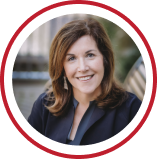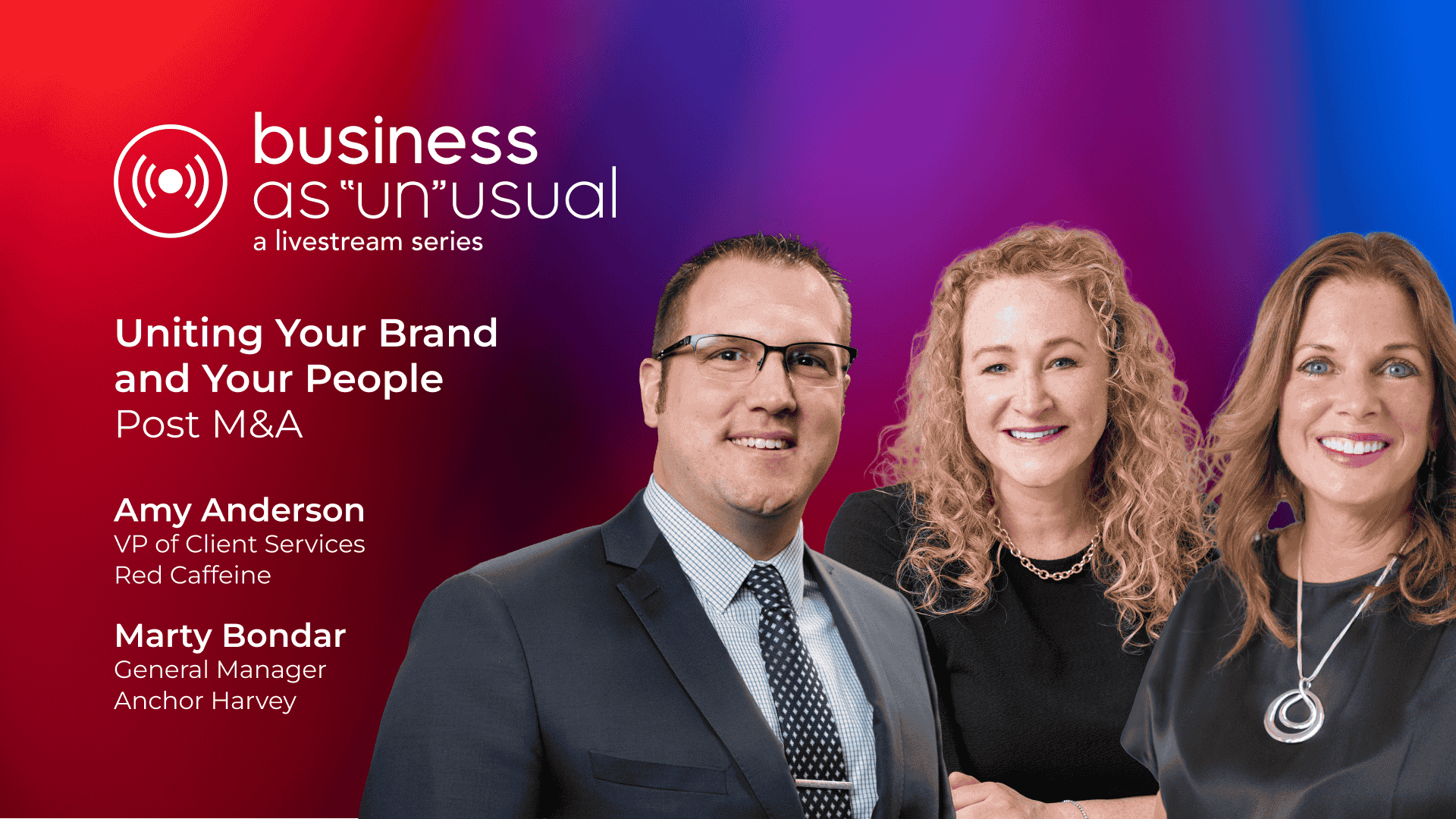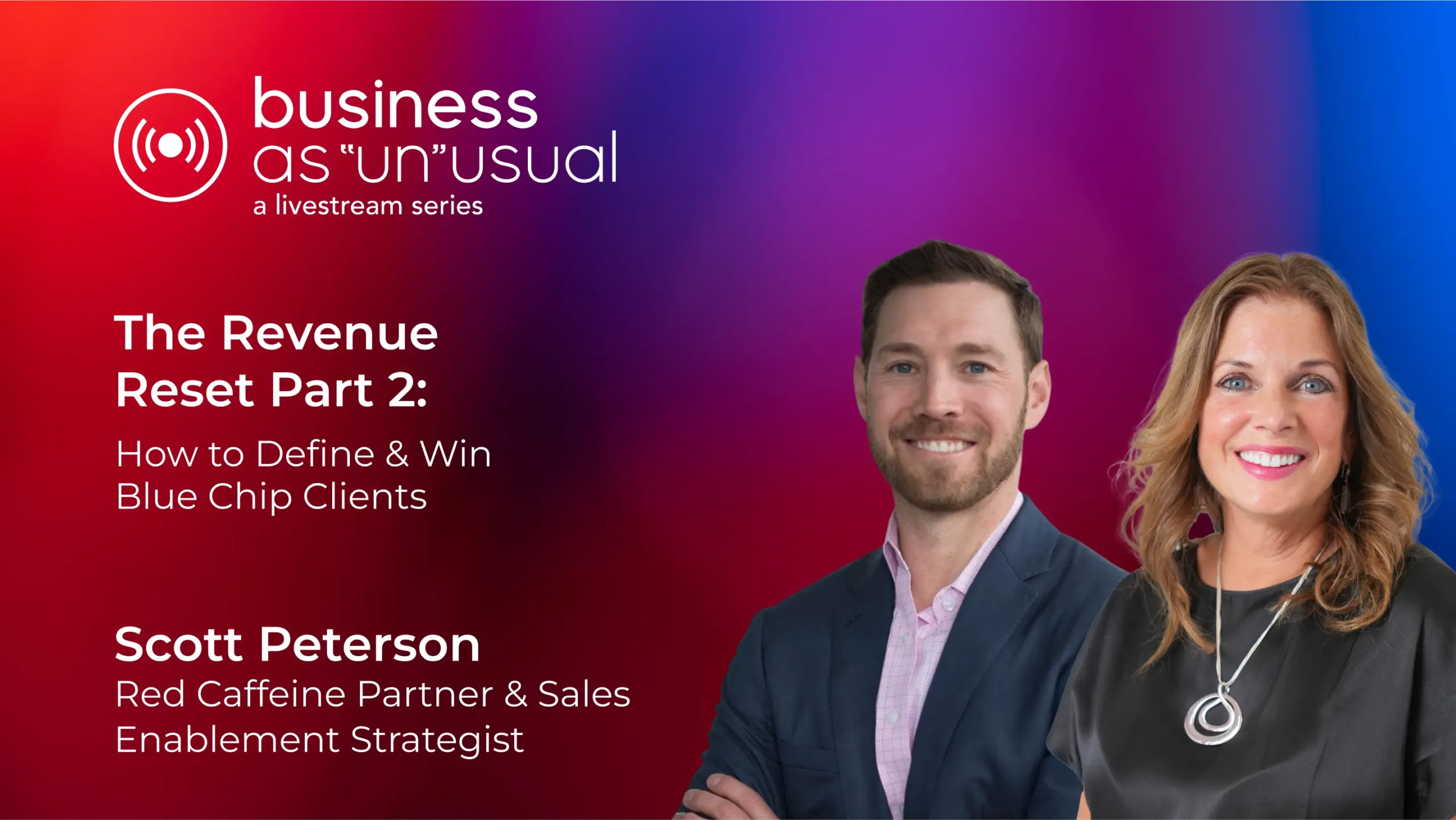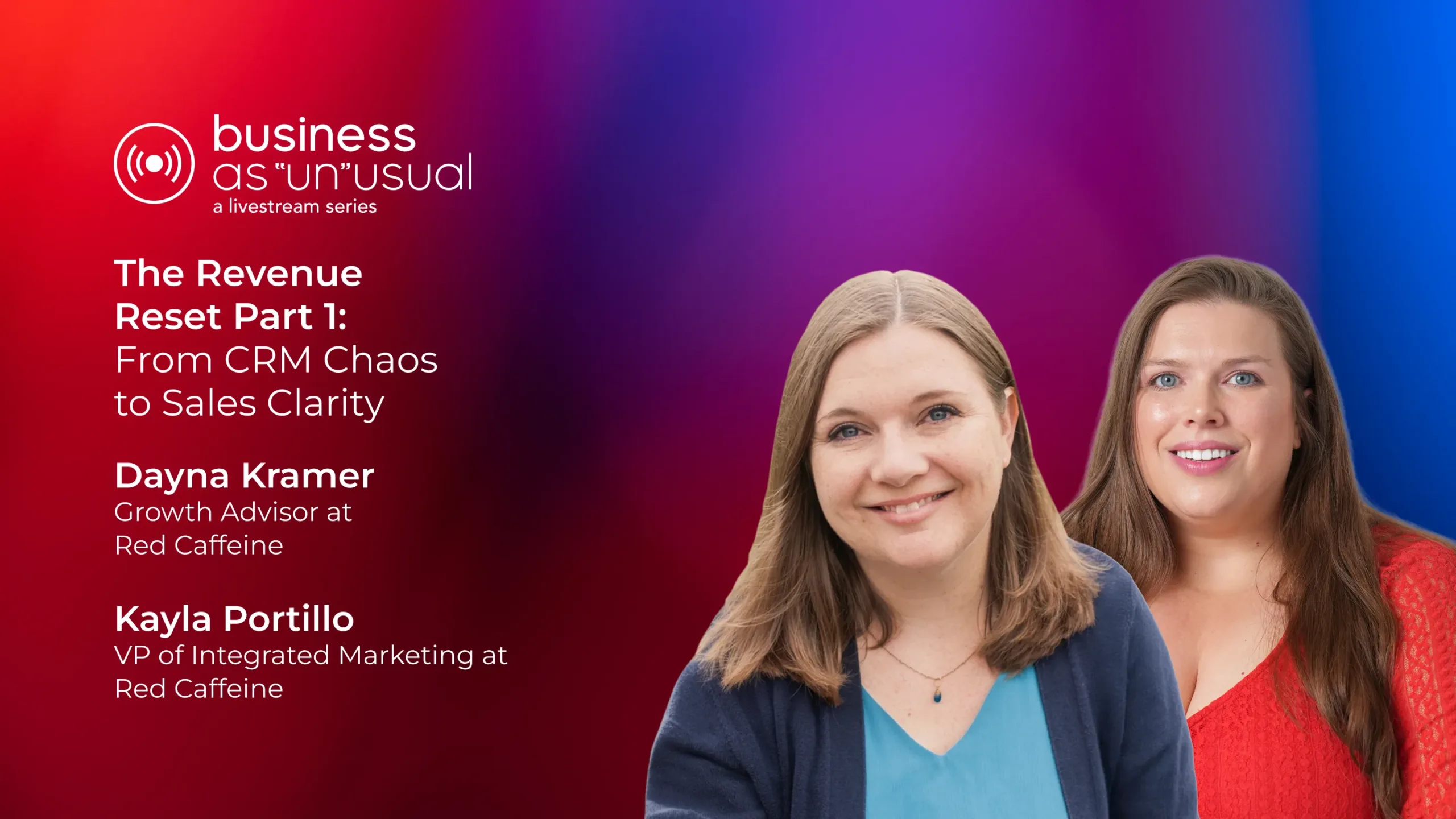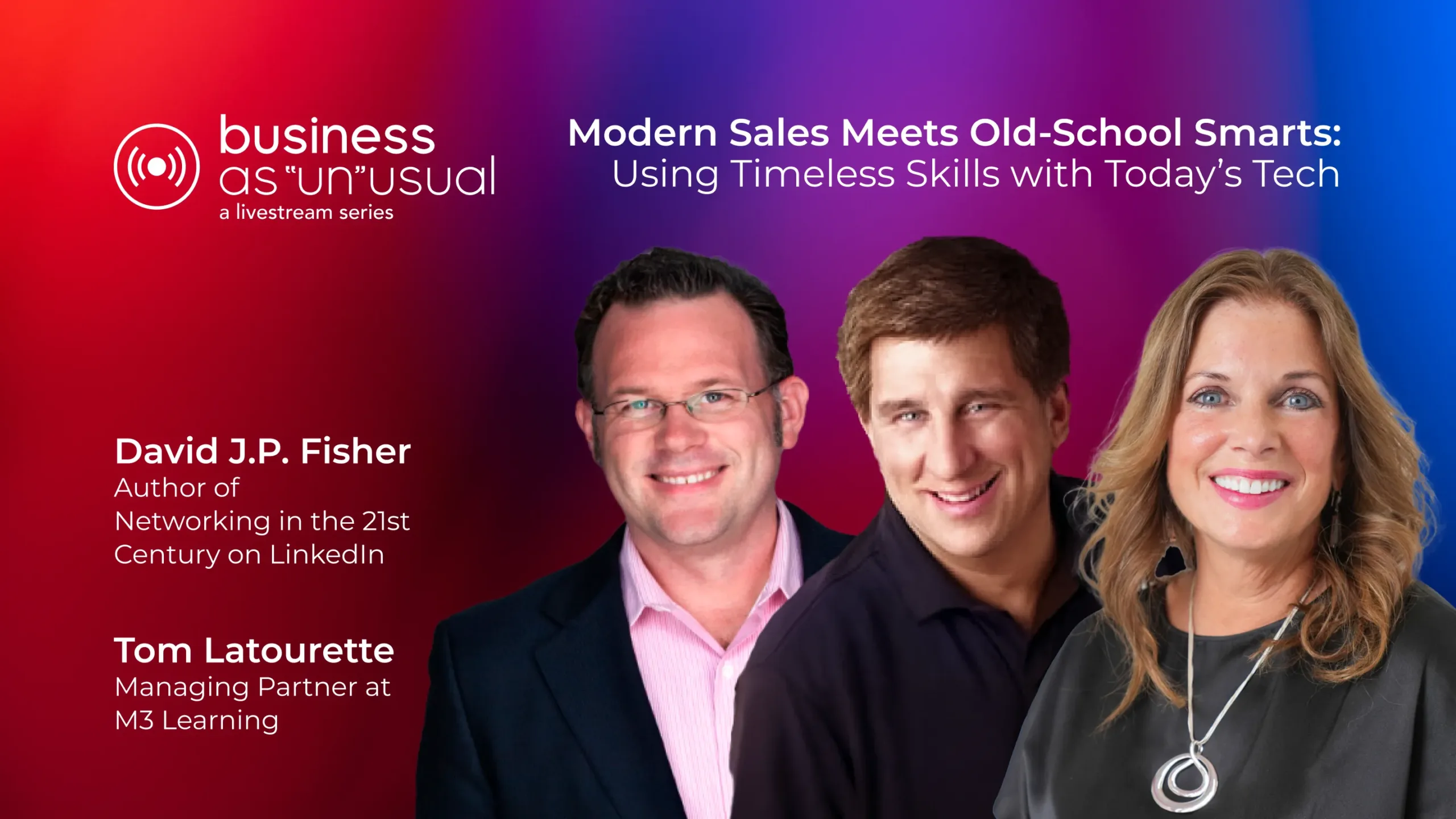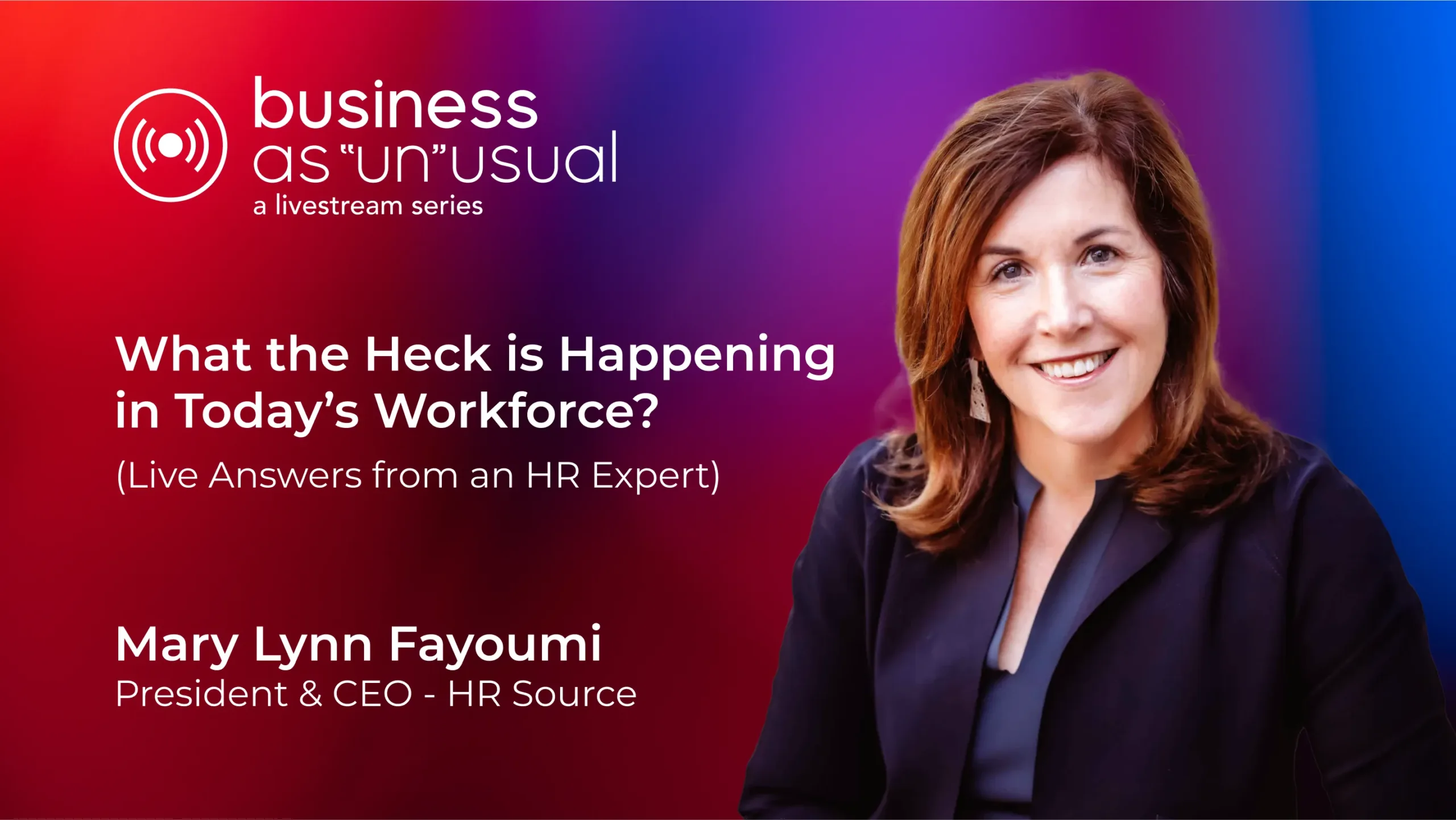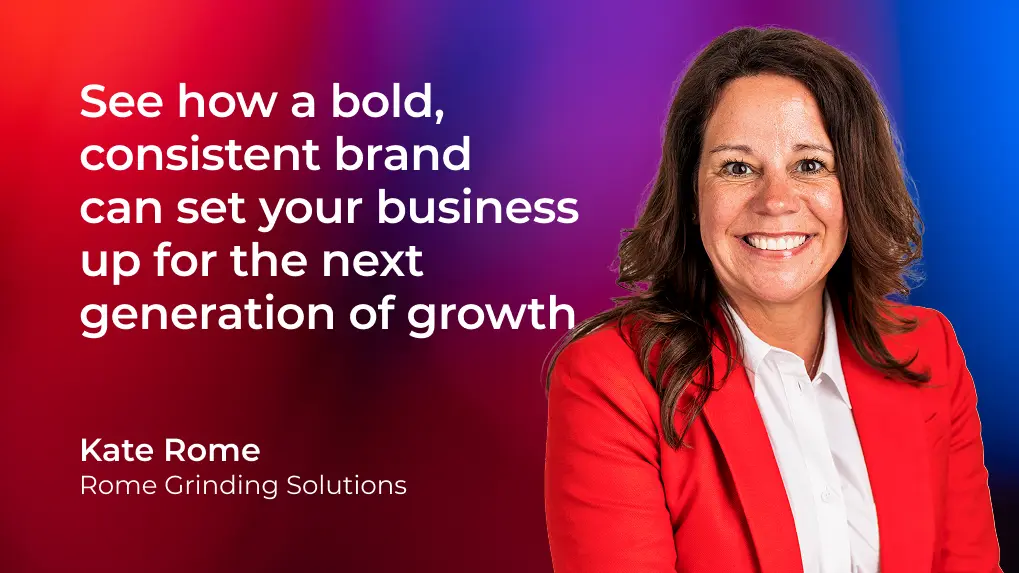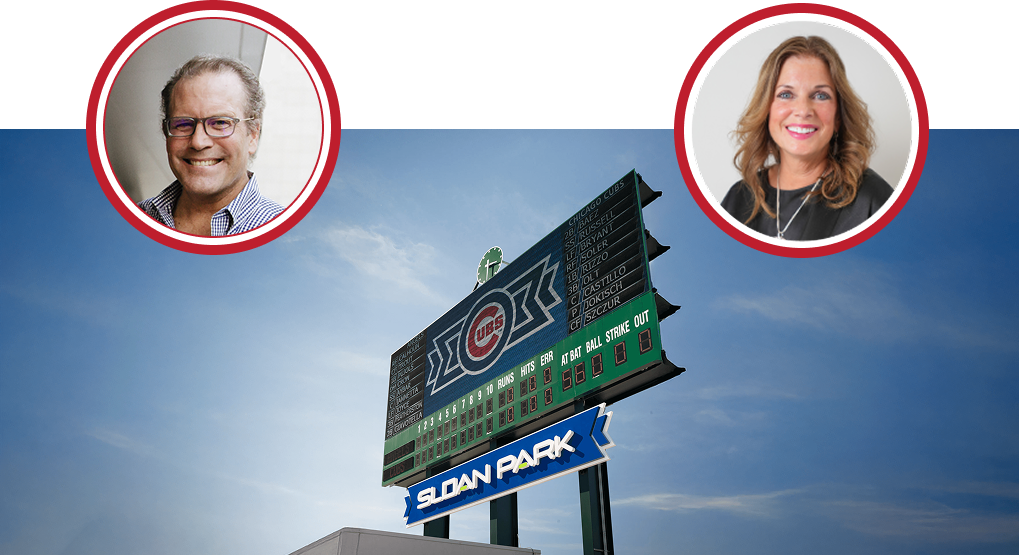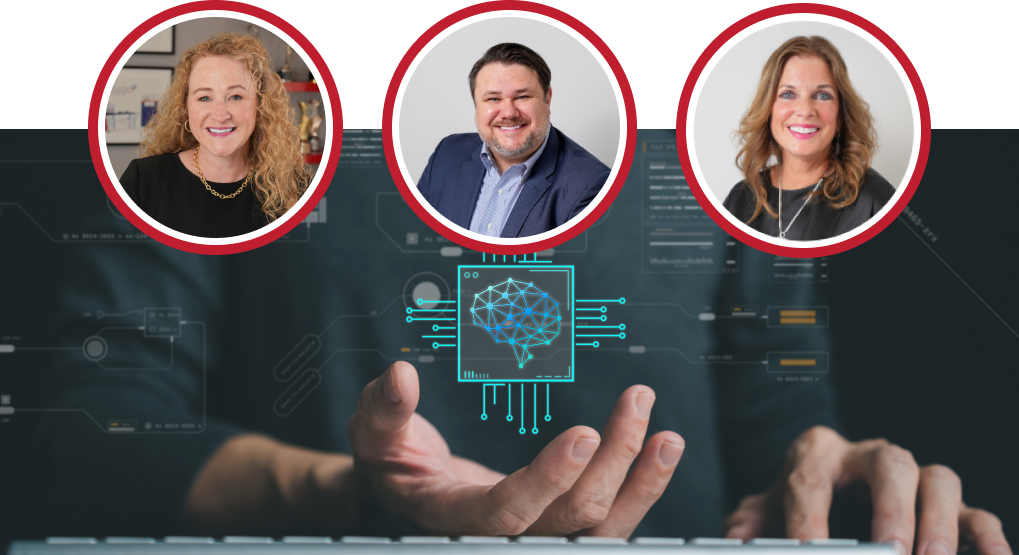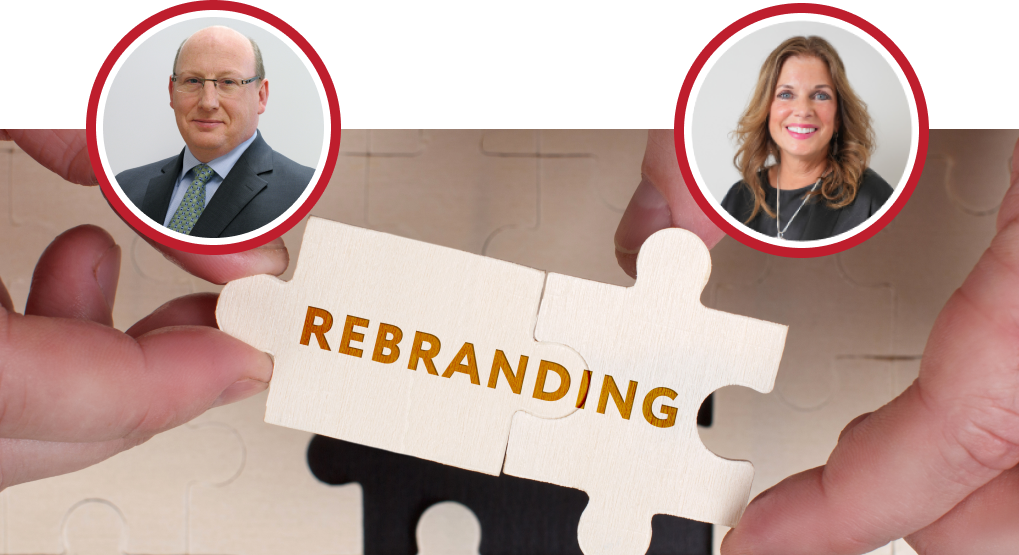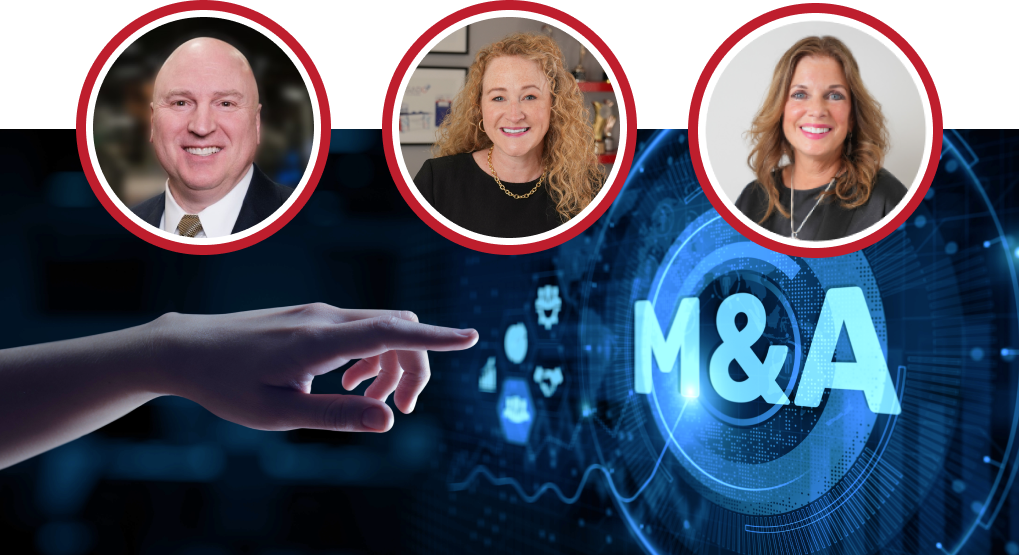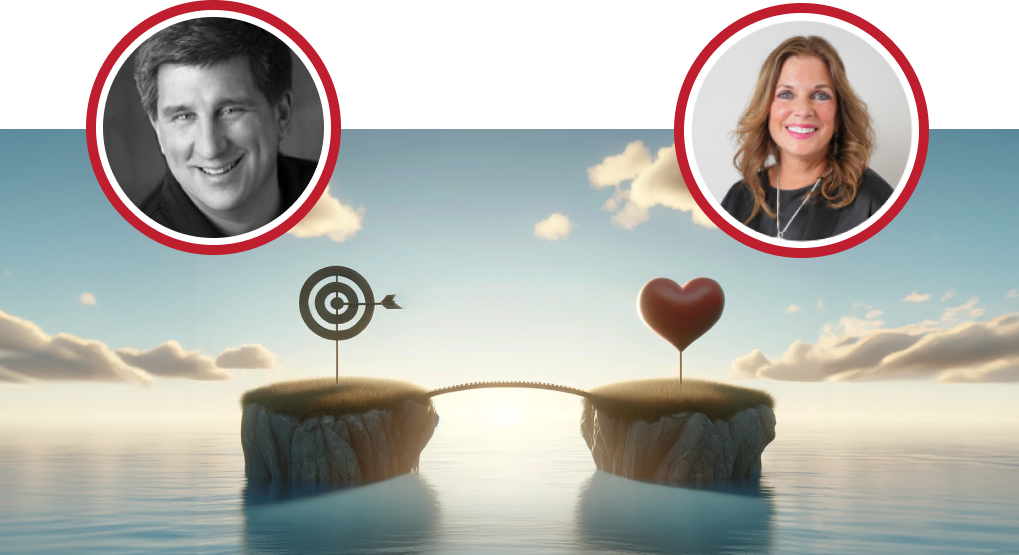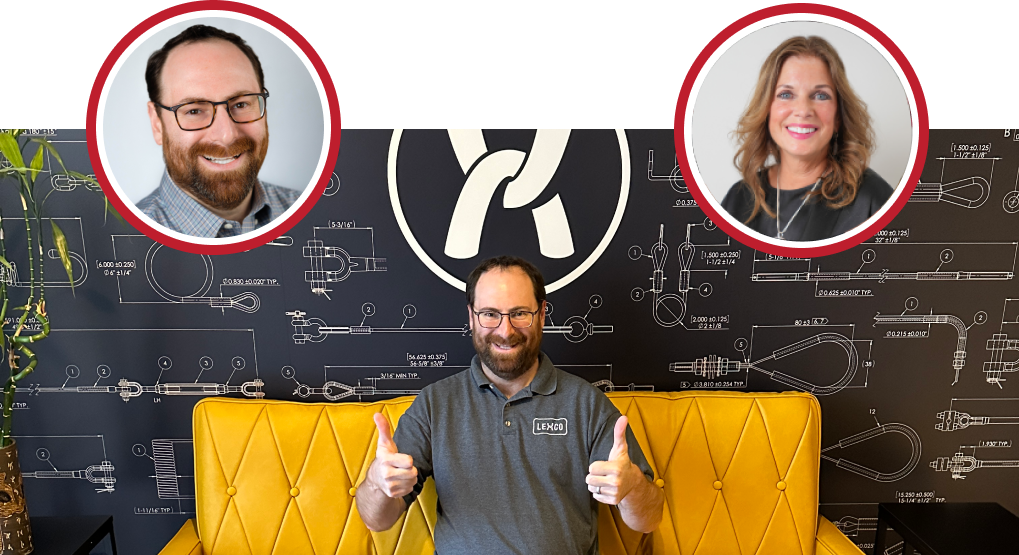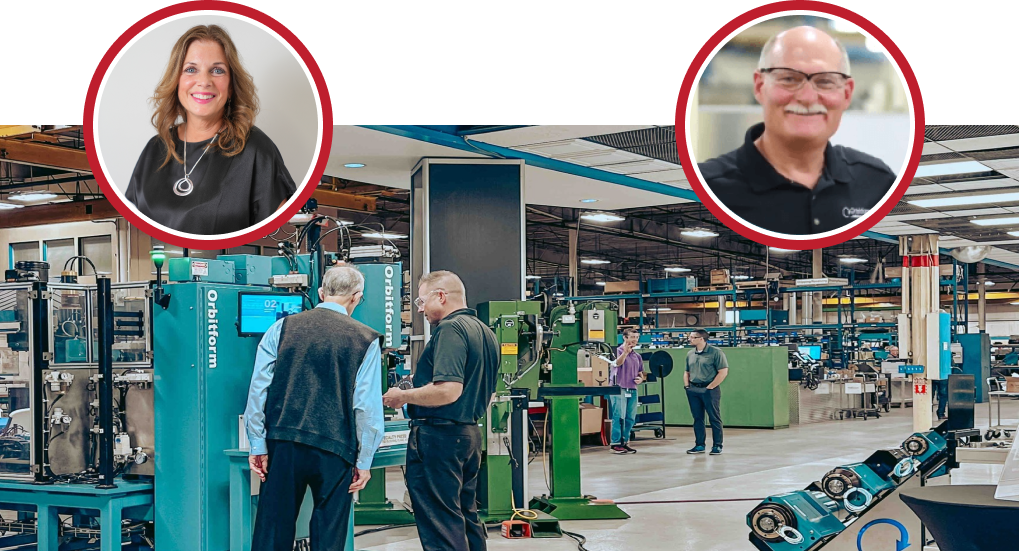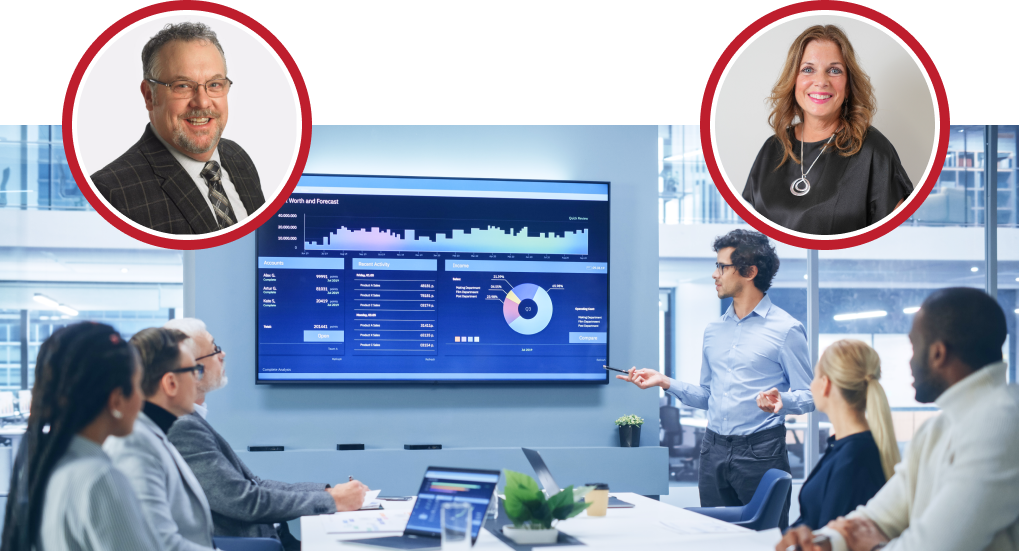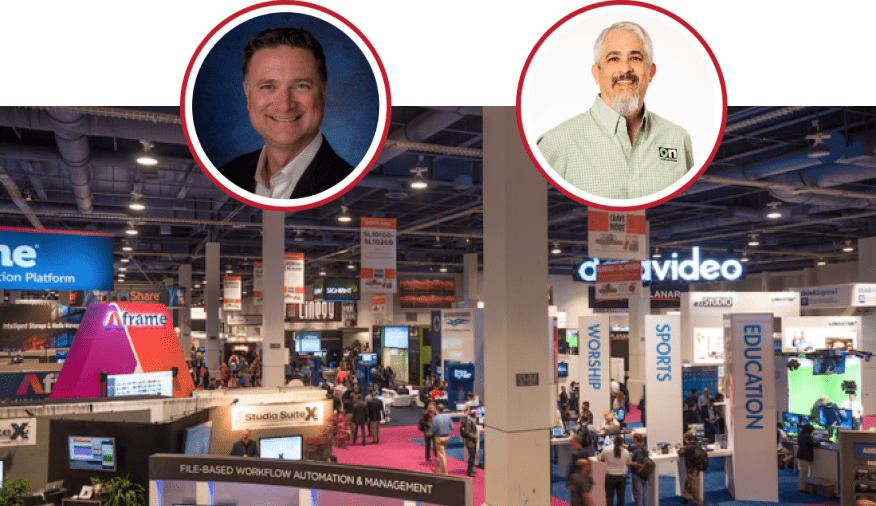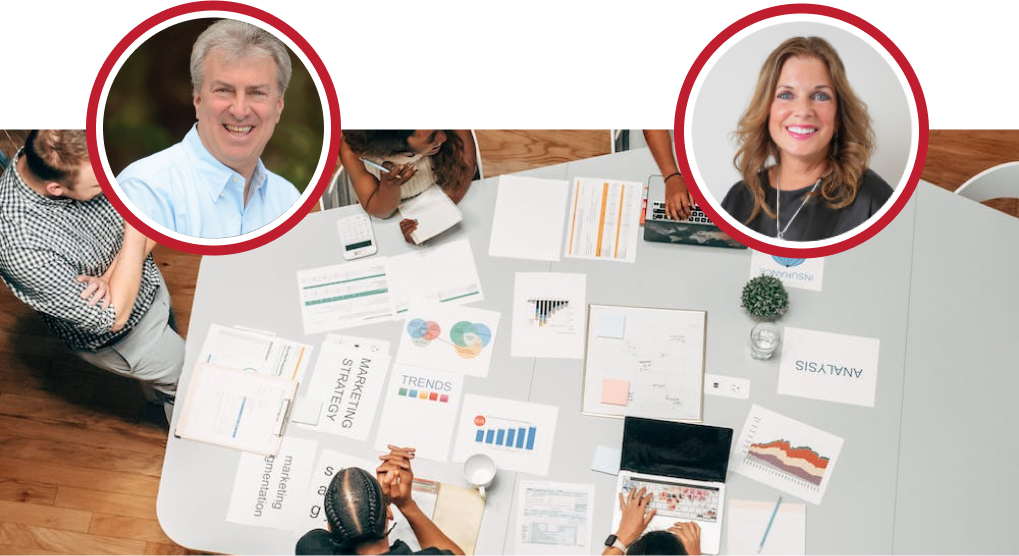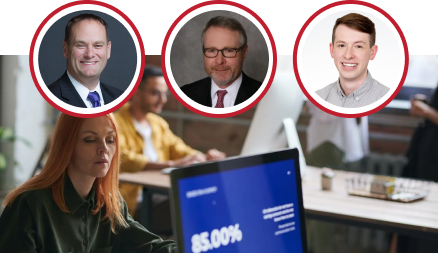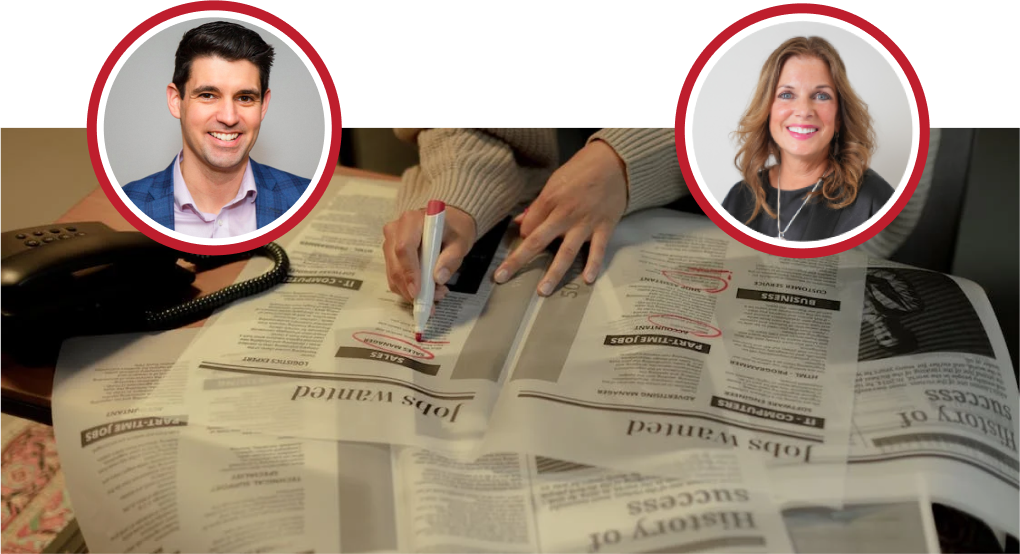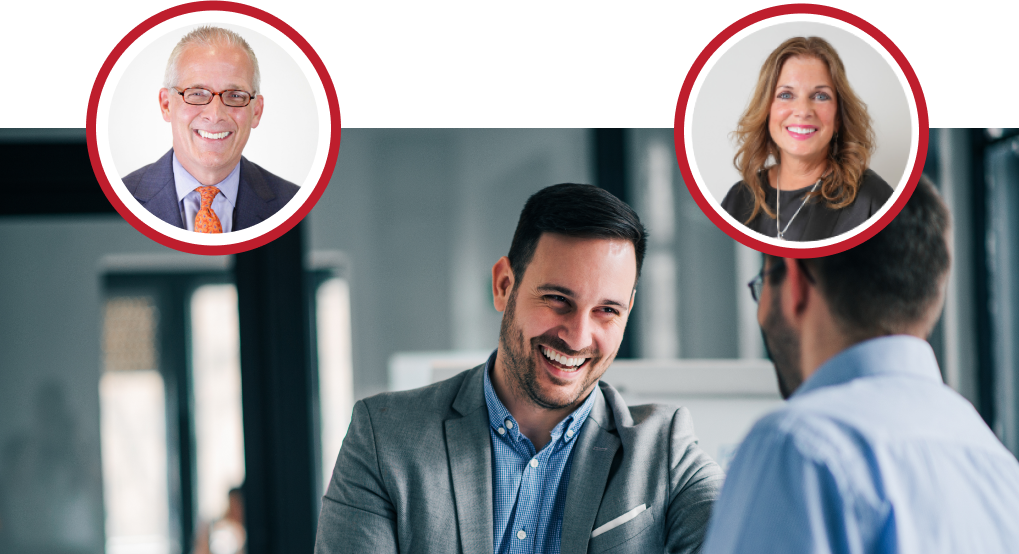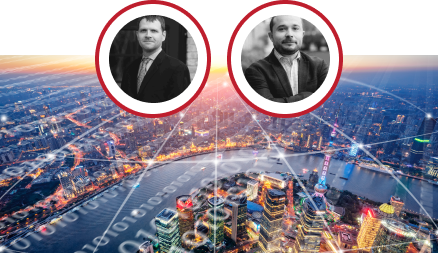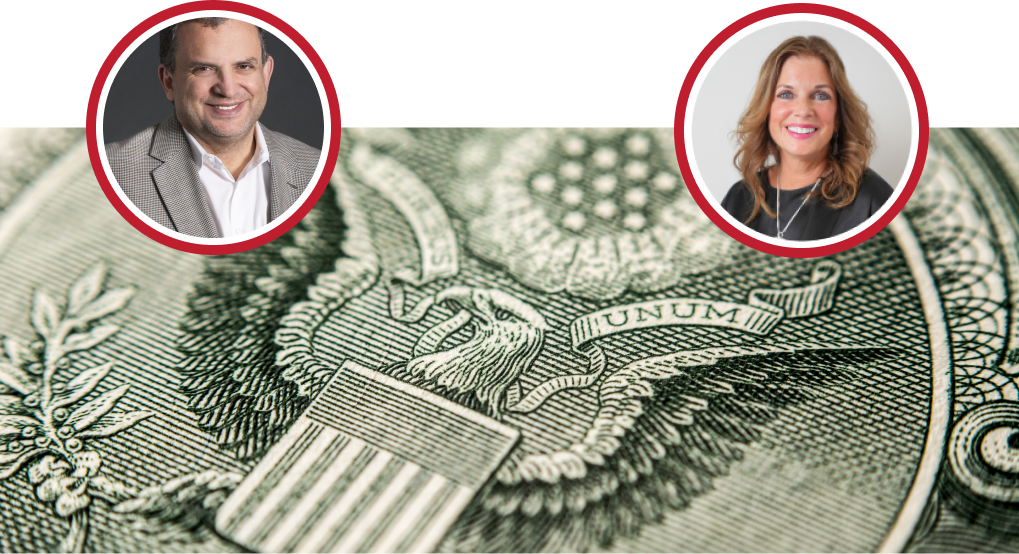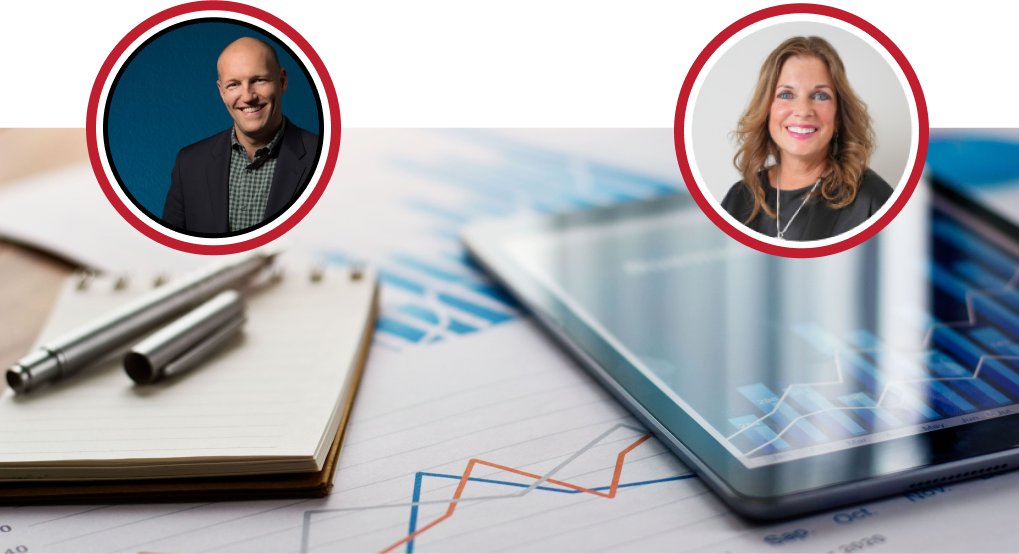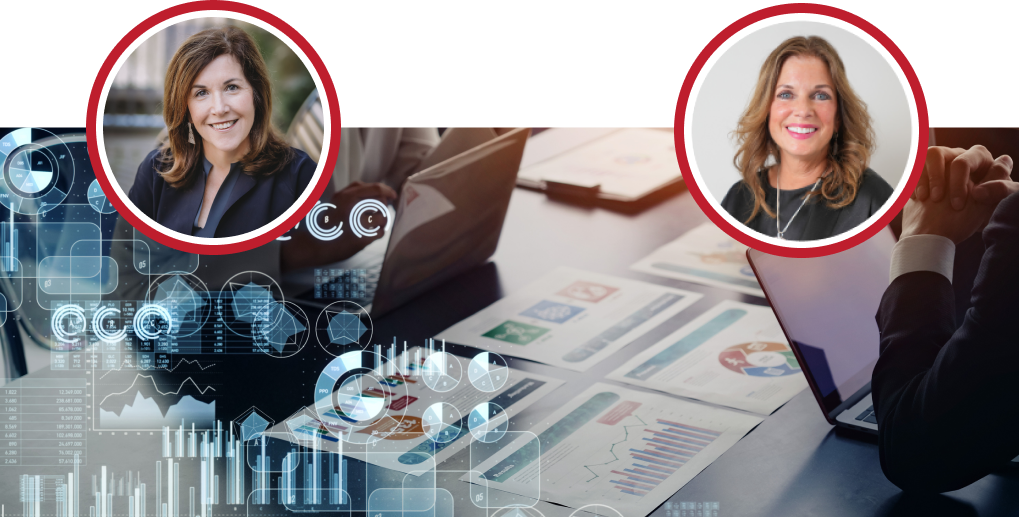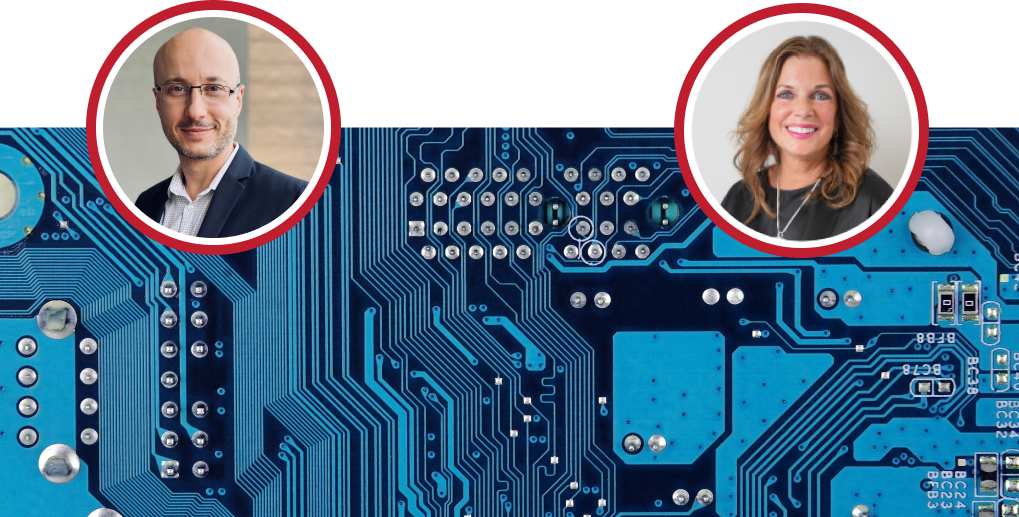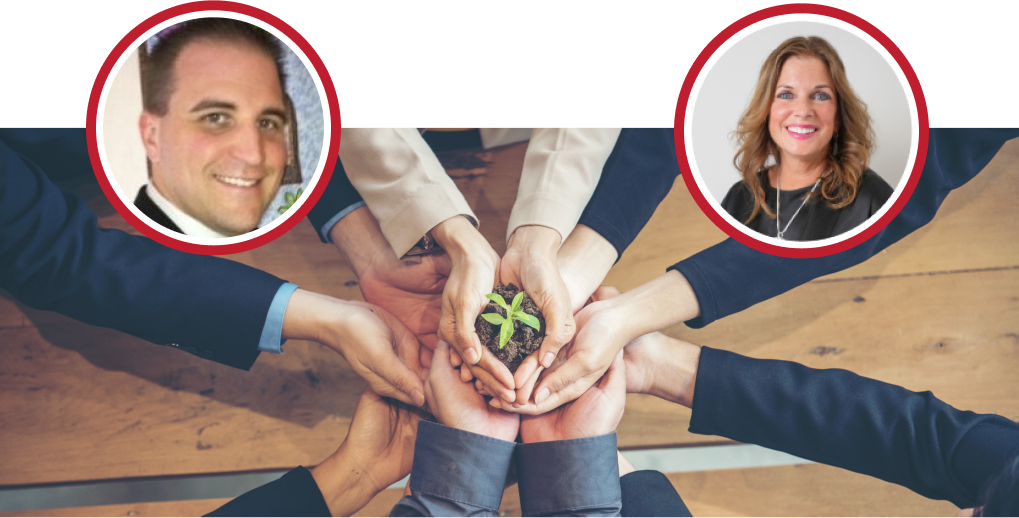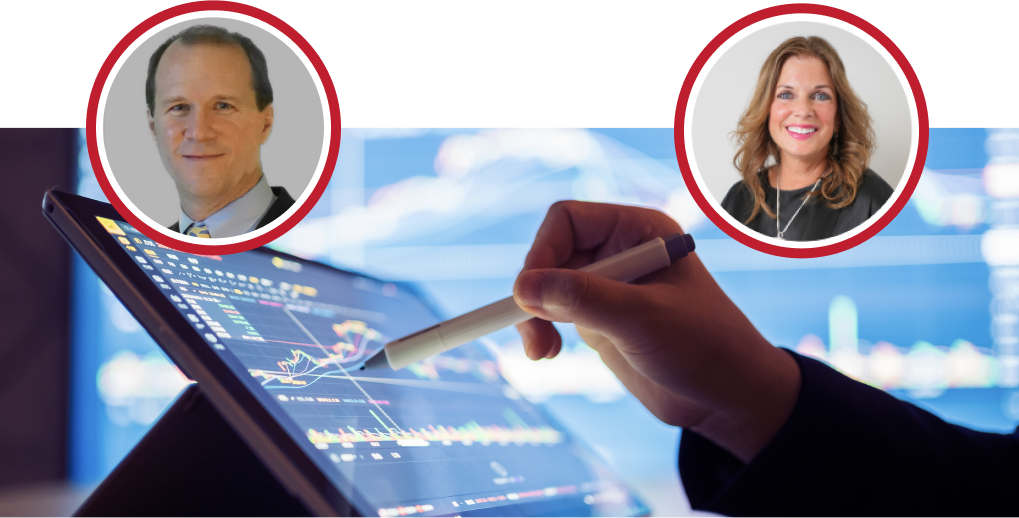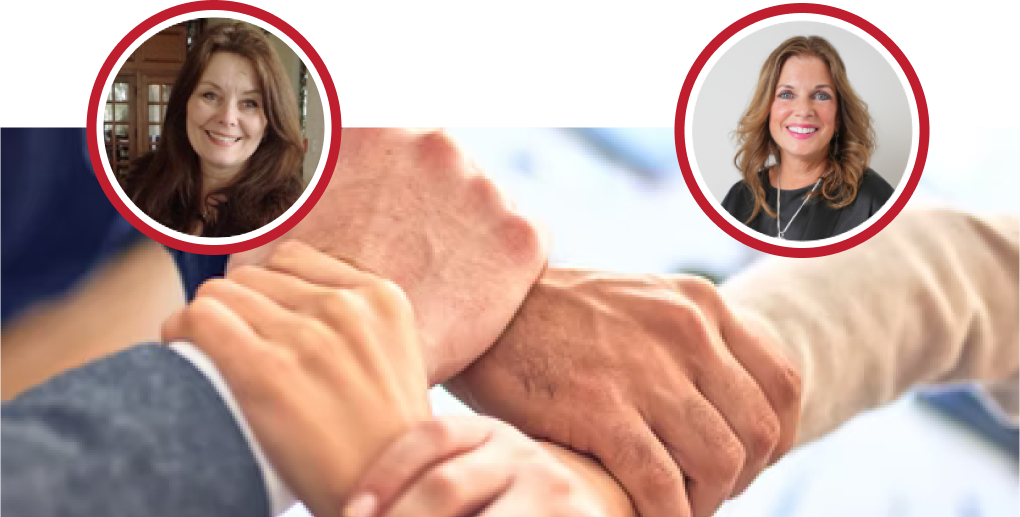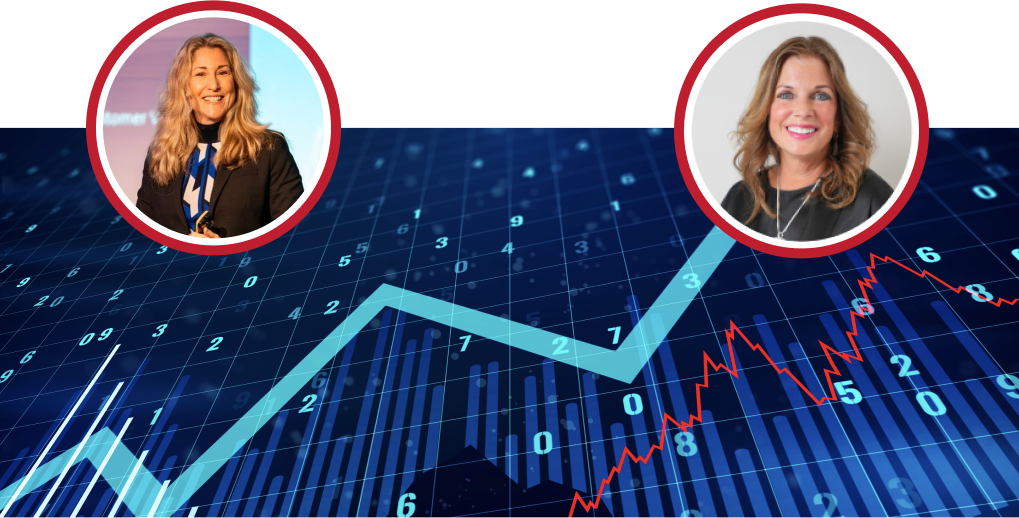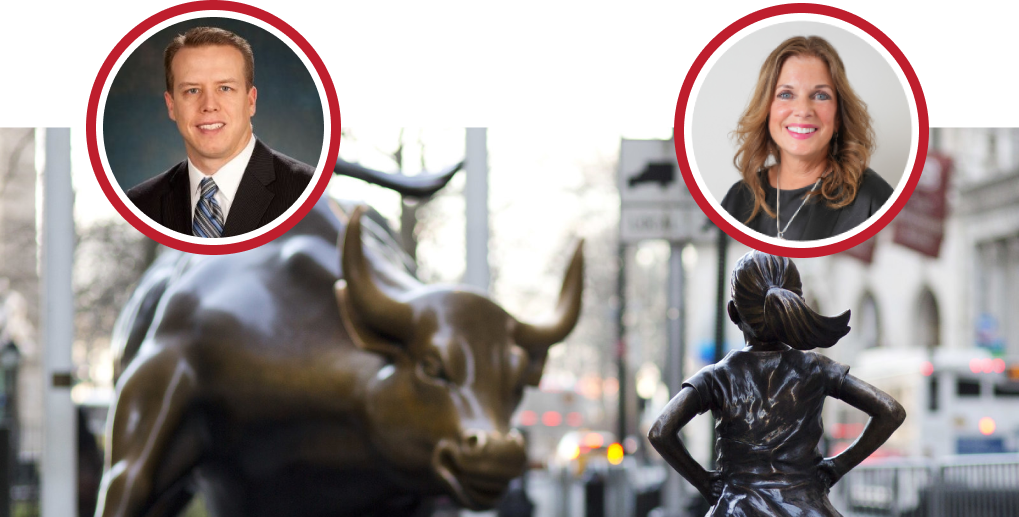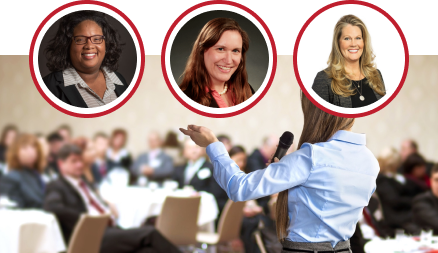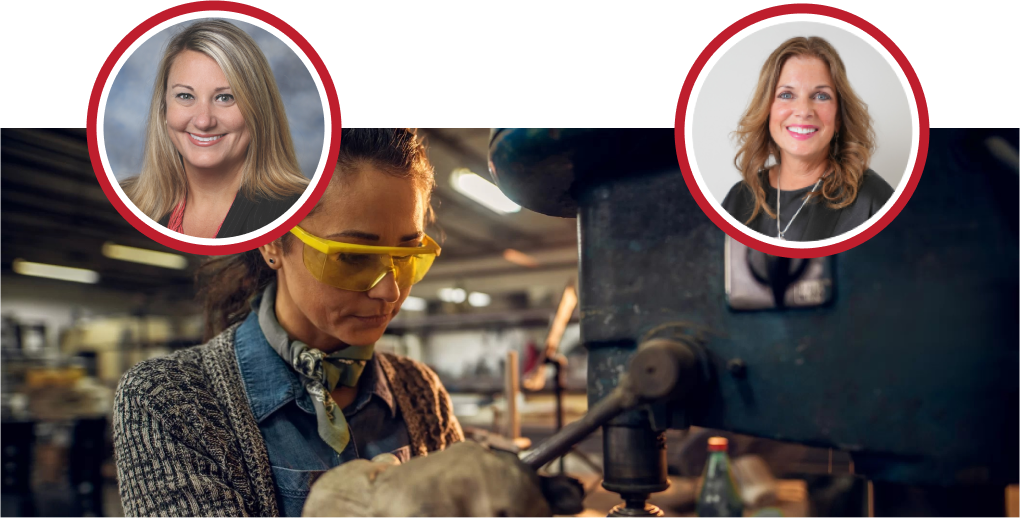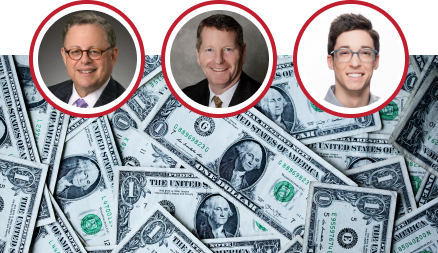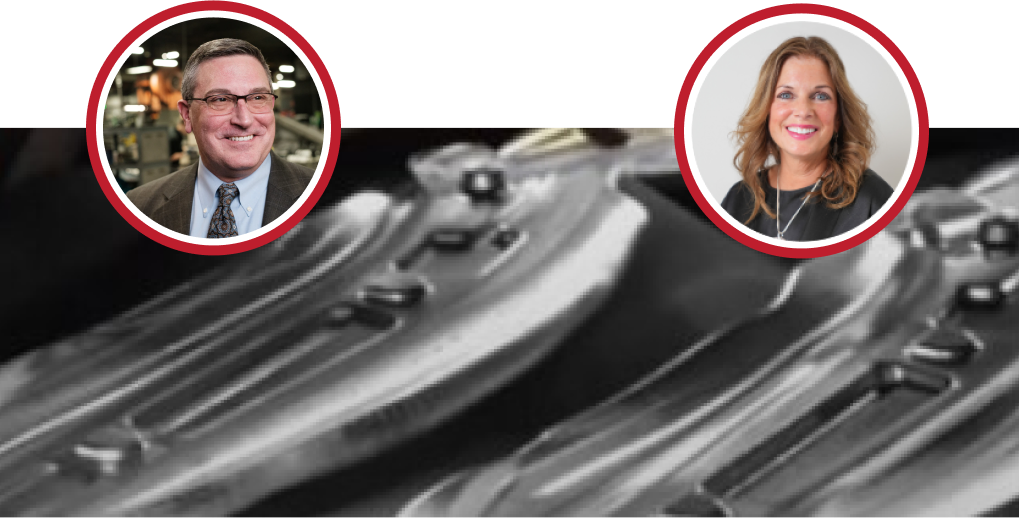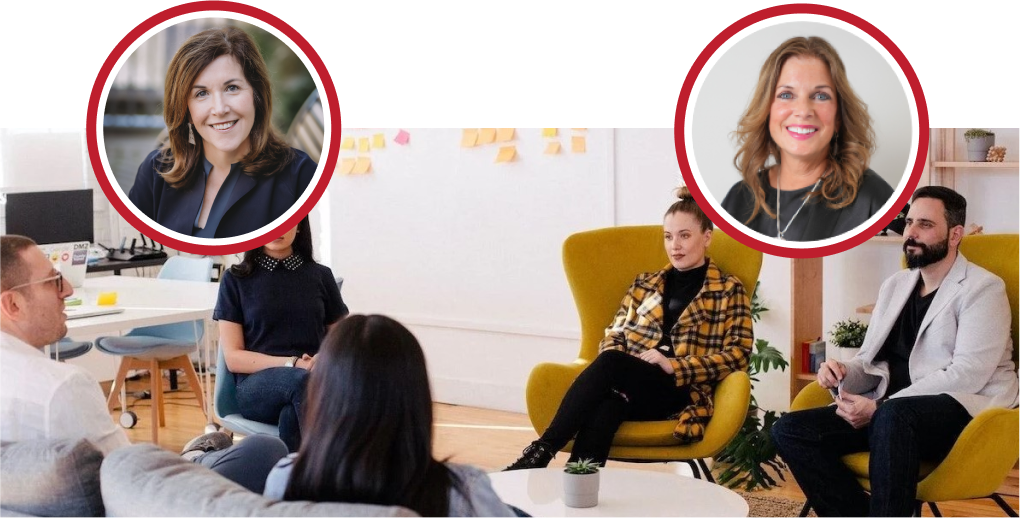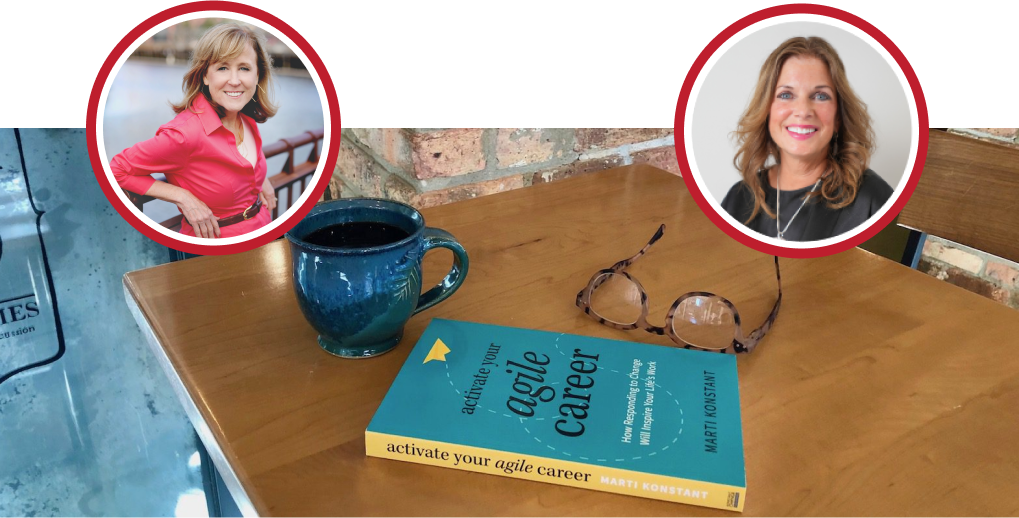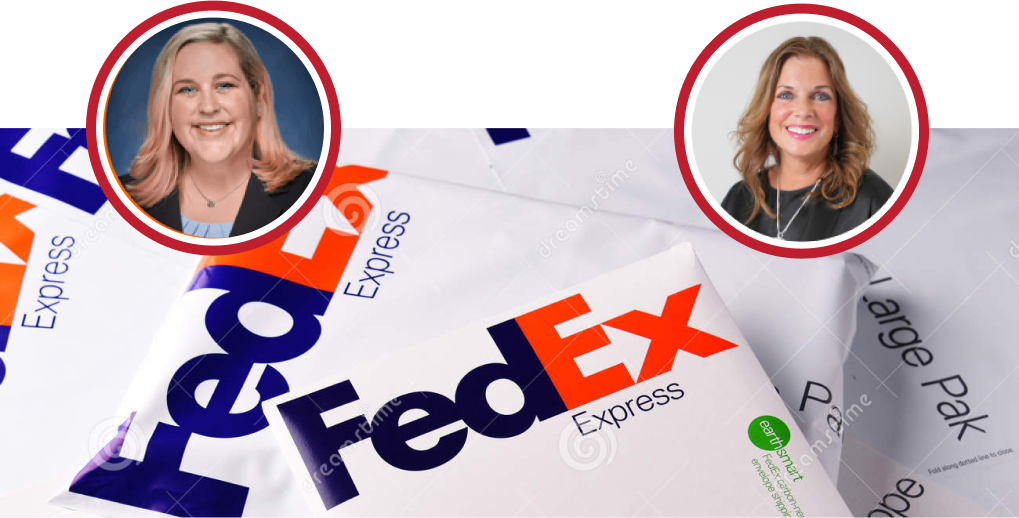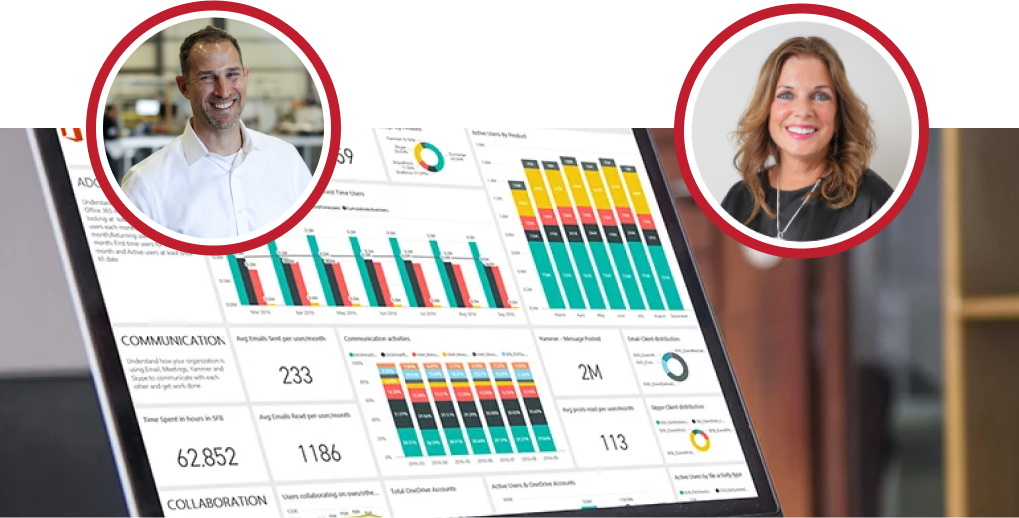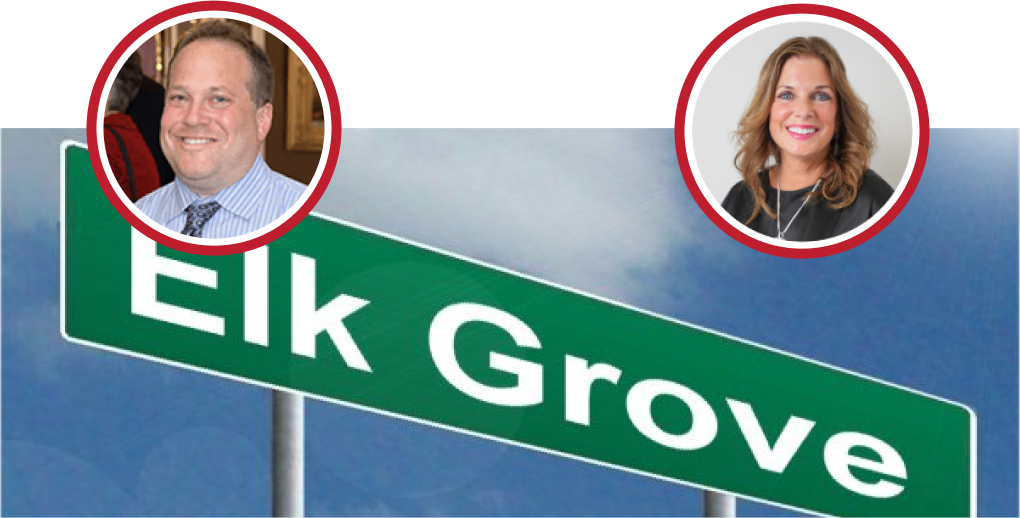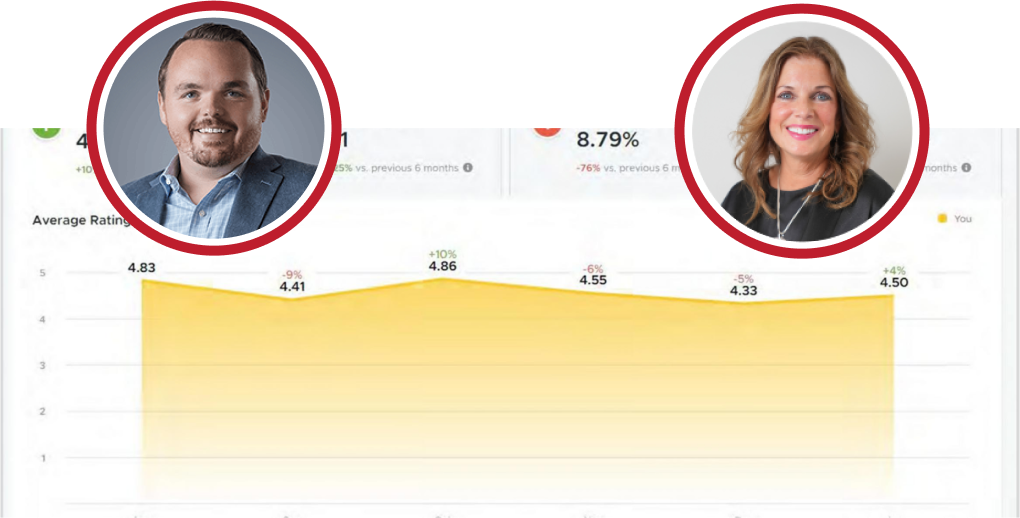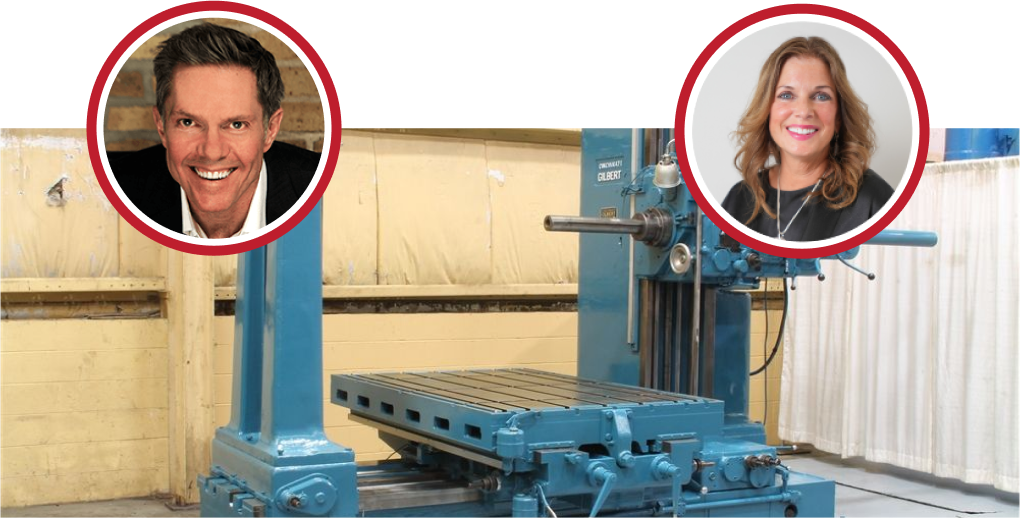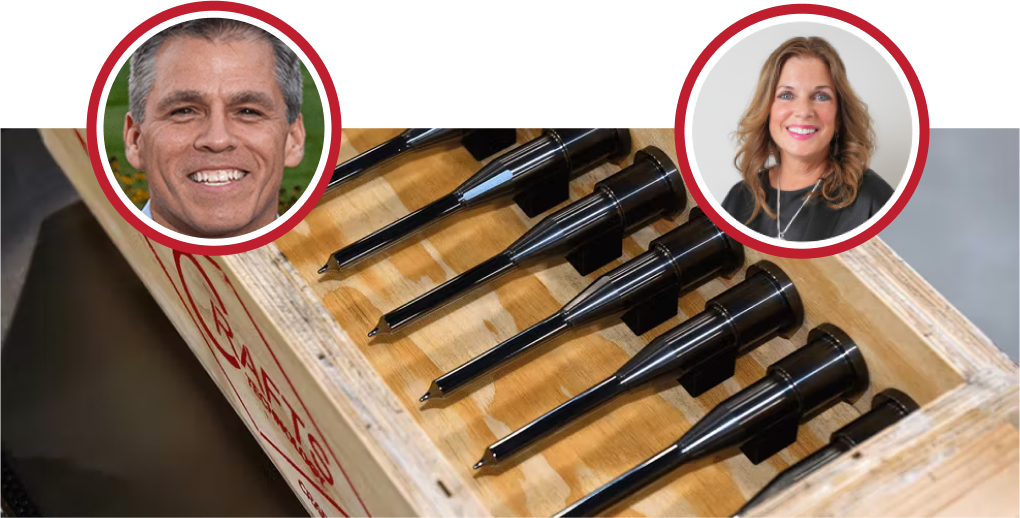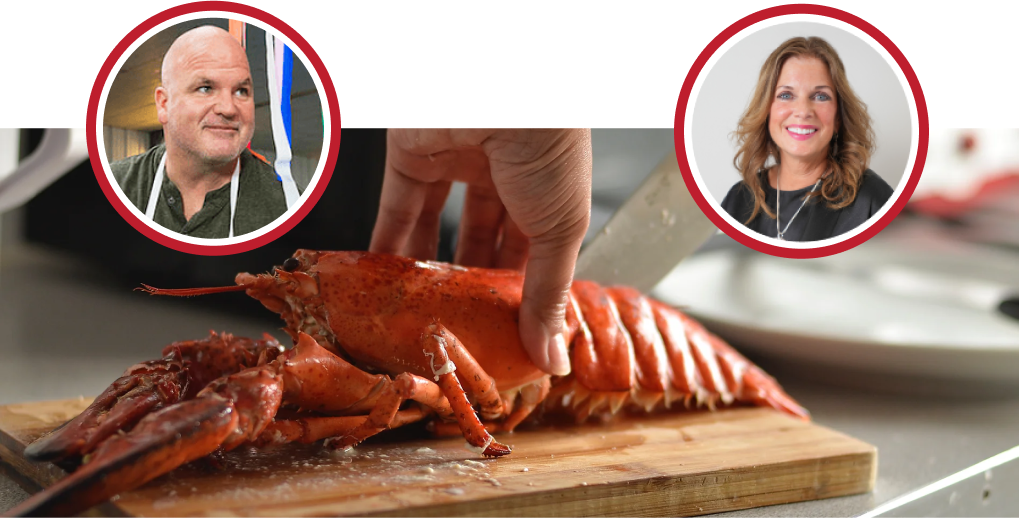Kathy: Welcome to the November session of Business as Unusual, the growth trends to watch in 2023. We’re going to get started in just a few minutes. So if you are attending by one of our live stream channels, please let Dana Kramer know she will be managing the chat in those channels. So let us know she’ll be entering questions in the chat, and we’ll be happy to answer those questions for you. So we’re going to get kicked off. I’m Kathy Steele, I am the CEO of Red Caffeine, and I’m your host today. And so, for those of you unfamiliar with Red Caffeine, we are a growth consultancy, and it’s our mission to build badass brands that people want to work for. So we love to focus our conversations with clients on their best growth opportunities. And so today, these are some of the growth lane options we talk about helping our clients build the right strategy, but sometimes that can be pretty daunting. There are a lot of different choices on this menu. So, we help companies build a strategy to accelerate growth by evaluating the path best for their business. Our offering includes a managed service team that enables a business to scale rapidly without making a wide variety of hiring full-time team members. As we all know, in this, challenging talent economy, that can be pretty beneficial, so today, we’ll be talking about many of these growth lanes because we’re going to be talking about some big topics. We will touch on sales focus topics like organic growth channels and expanding your sales channels, as well as launching a new product or service. We’ll talk about the hottest topic in every CEO fishbowl I’ve been in recently. What’s on the my the most leaders today is their talent strategy. Then we also touch on the technology you’ll need to optimize growth in sales and hire. So without further ado, I’m going to enter reduce our experts today. We are joined by Marilyn Fayoumi. If you are a regular visitor and Watcher of our webinar series, you will recognize. Mary Lynn is the president and CEO of HR source, and they’re a Chicago-based employer association with over 1200 member organizations, so she sees everything. She’s a highly respected speaker, trainer advisor, and Authority on various workplace issues, including culture, employment trends, and HR management. She’s also a prolific writer quoted and published regularly in various industry Publications. She is the past chair of the board of directors and Association Forum of the Chicago land and the Employer Association of America. She currently serves on the world of work board of directors, so very busy person. Hence, I’m sure those are some factors that got her recent recognition by Chicago crane Chicago business. She’s been recognized as a notable leader in HR. Welcome back, Mary Lynn.
Mary Lynn: Thanks, Kathy.
Kathy: Another frequent guest on our webinar series is Tom Latourette, and Tom is the managing partner at M3 learning. So M3 works with companies as large as Google and WebEx to entrepreneurial startups. Their Solutions change the way your sales teams will interact with their accounts. The relationships will be at higher levels, they’ll grow deeper and stronger, and they’ll be more collaborative as the tools transform. How your team communicates at every level of the business and it will give you the team a framework to engage, qualify and close more deals. Tom has been a disciple of the M3 learning process since 2000 when he was the VP of sales and marketing at SBR Inc with over 26 years of Marketing sales and sales management experience. Tom can bring a unique real world like he has done the job perspective to the M3 learning experience. Thanks for joining us today, Tom.
Tom: Oh my gosh, thanks, Kathy. I really enjoy these programs; thanks so much.
Kathy: We love having you, so, and then we have, last but not least, Joe Gurreri, and he’s a certified business performance advisor with Insperity, and Joe helps leaders prevent people’s problems. I love that while accelerating performance which I also love, Insperity is the original professional employer organization, a PEO, and Joe says he acts like a bit like a business therapist, which I love. I’m sure there are some stories to tell there, and he focuses on what keeps small businesses. Mid-side Business Leaders up at night the people process and performance issues, and I think anybody that’s running a company or managing people today would agree that those are some of the things that we’re all challenged with inspirity spoke scope encompasses the ABC twos of HR the administration benefits and compliance. Still, the force multiplier is culture, so welcome, Joe.
Joe: Thank you happy to be here.
Kathy: And I always love for the audience to get to know you guys a little bit more personally, so Mary Lynn, what’s not on your bio that you can share today?
Mary Lynn: Oh, that I love to travel, and I love having adventures and try never to grow old just through continuing to embrace. I had a birthday this week, and I’m moving up in age, but my youthful Spirit remains, whether it’s through my music, my hobbies, hanging out with young people, and traveling the world brings me unlimited Joe.
Kathy: Well, that’s fabulous happy birthday or happy belated birthday.
Mary Lynn: Thank you.
Kathy: I also am subscribing to Benjamin’s buttons philosophy about going backward and Paige, so I’m with you. I’m with you at that age, and Tom tells us something fun about you.
Tom: I am a children’s book author, and my fourth children’s my third children’s book I had a rotten tooth about Billy by cuspid and the rotten tooth gang, who are gonna hijack the Sugarland the candy express it high noon but are thwarted by Dominic the dentist and Bryson brush that’s my third, and then Opera baby is coming out shortly, and 100 of the proceeds of those Book Sales go to a foundation that my brother and I created that helps local families that are fighting cancer the BTV btb Foundation is given over 1.5 million to over 100 local families, and Joe has graciously supported with his prodigious talents probably Joe for the last ten years. Kathy, I know your organization has sponsored our events, so that’s a little something about me.
Kathy: Oh gosh, well, definitely a great reminder for our Christmas or holiday shopping list, so thank you for reminding us to spend some dollars on something that’s really fun for kids and a good cause, and Joe just give us a little something about you that’s not on your bio.
Joe: Okay, well, Tom suggested it a bit there. I am a vocalist, and as one of my hobbies, I am in a men’s acapella chorus called the new tradition Chorus. For those of you in the greater Chicagoland area, there’s a holiday show coming up on the third and the 4th of December, so we’d love to have you there and. I do this competitively, so I was in three competitive quartets and two competitive choruses this season just this year. I’ve traveled all over the United States and had a lot of fun doing it. It’s fun to look out at the audience and see people smile when we do things the way we’re supposed to and bring the chords together.
Tom: He’s an award winner and the best version of blue skies you’ll ever hear in your life.
Kathy: I’ve been thrilled to hear you sing before, and you are. It’s just spectacular so well you, you really out, you all really outdo my tennis and golf habits, but let’s jump into the topics at hand. So Mary Lynn, why don’t you kick us off so hiring, as we’re entering an economy that is truly in flux. I, it, and it really feels a bit counterintuitive. Still, what’s your thinking on, being like entering 2023, should companies grow their Workforce as other organizations are starting to tighten their belt or, we see, some massive layoffs across certain sectors what are your thoughts on that?
Mary Lynn: It’s dangerous to start a program with an answer like it depends, but this is true of those questions that it depends on your current talent, your industry, your geography, your growth potential. My optimistic self says yes a hundred percent, but for some organizations, it’s not in the budget, it’s not in the cards, and it’s not in their best interest. However, even in organizations where they are downsizing or belt-tightening or, having limited reductions in force, they’re also going to suffer from some turnover or attrition during any year, and 2023 will probably not be any different. You have to be living under a rock to have not heard of the great resignation, quiet quitting, and quiet firing; all of these things are gonna continue into 2023. I think that’s what my crystal ball shows to some extent. So organizations, at the very least, are going to need to fill positions for critical roles where there has been some turnover. Still, they also need to be looking at opportunities to grow their talent. Hence, any good leader is also a talent scout. So we should also be looking at this opportunity when there might be some talent in the market that has been laid off, downsized, or has chosen to leave their employer because of remote work flexibility may fill in the blank we might be able to pick up some talent that we wouldn’t otherwise be able to score.
Kathy: Right.
Mary Lynn: So, generally speaking, I would say yes, even though we’re looking at an economy in flux, organizations will still be growing their Workforce in smart, effective ways to be successful.
Kathy: So well said. I love it, Joe. I’d love to hear your perspective on this topic too.
Joe: Yeah, I’ll be happy to. First, you have to look at your business goals for 2023. and say to yourself where do you need the help, so I’ll give an example, I have a client that’s a mortgage organization. They don’t need processors right now, but they really need Originators. So look where your business is telling you to look. Make sure you’re flexible enough to react right now, but at the same time, like Mary Lynn said, it depends. At the same time, you have to look at what is the next wave of the business cycle bringing to you. You can’t cut your nose off now and get rid of all of your processors, or you won’t be able to hire them when your business starts to surge. So there’s that delicate balance any business leader doesn’t already know but think about this I think more strategically you could use this as an opportunity to consider your succession strategy what does it look like how do you prepare the next leader maybe you have an emerging processor that could be developed during the slow time and they might be less expensive they might be earlier in their career they might have a role today that doesn’t Garner the or earn that higher range of pay set up a mentoring program so that if you do have to lay off you’re not losing that that core tribal knowledge of what makes the business successful and unique and different and you don’t want to lose that essence of culture so you can be strategic about it while still being compassionate you can reapply people’s skills to True business values but you have to step a little bit farther outside of your business and look at it objectively sometimes it helps when you have a trusted advice is there anybody a friend another someone in your Vestige group Kathy anybody to objectively look at it and say did you think about this or did you think about that but really remember this one thing is have a deliberate succession strategy figure out how you’re investing in people so that you’re not left in the next wave fully unprepared yeah.
Tom: Kathy, I just wanted to add what I’m hearing from both Joe and Mary Lynn is it’s that place of taking the Long View with your individuals, and because if I train somebody to get them to that next level boy, it sure makes it really difficult for them to want to leave me a year or two from now if I’ve invested in them they’re willing to stay longer they’re going to invest with us and even the Long View of just when I attend a trade show my eyes are always open for who are the good who are the good competitors that are out there and maybe I just take their name I put them in a file somewhere because you never know what’s going to go on three months six months from now.
Joe: And Tom, you’re pointing out a good point, and that is it’s a win-win to do it this way.
Tom: Yeah.
Joe: Because you’re investing in people and there’s a win, you’re buying loyalty very likely, and if you can ratchet up the performance of every single player that is still here a little bit. I’ll go back to the singing example in a quartet. If one person is not doing well, we want to help that one person do it, or the court isn’t gonna happen same thing with a chorus where you have 60 or 70 voices. If you have a few people that are kind of dragging it down, we need to help them bring it up, or it brings the whole performance down. When everybody does it great, it’s unbelievable and did that when you have four voices singing a song. They’re doing it right. It creates a fifth sound, an overtone. That’s what you have to strive for in your business harmony literally, you have to have that Rhythm you have to know, and you all know it you’ve existed, you’ve, you’ve seen it happen when there’s that little magic in a business that’s when you’ve got everybody pulling in the same direction the culture is really clear people feel appreciated and motivated. Money isn’t always the answer.
Tom: Like money becomes maybe this third or fourth motivator, right?
Joe: That’s exactly. Yeah, people leave supervisors and culture. They don’t leave a good environment. They leave supervisors who are not good at what they’re doing or are frustrated.
Kathy: Yeah, and I, so that kind of leads into the next question is is so then what are some of the top trends that companies should be considering as they’re, maybe, thinking a little bit more careful about their hiring processes or in their organizations like what are some of the trends that you guys are seeing people invest in both Talent acquisition and trying to retain those top performers Mary Lynn why don’t you kick us off.
Mary Lynn: Yeah, well, there’s a long list here. We could spend the rest of the program on this, but we’ll I’ll try to name a few and then let my friends here name a few others. Overall, I think it’s critical to look at your total rewards well as compensation is getting the lion’s share of the attention right now because of the rate of inflation, it is critical to look at that as one ingredient in your overall compensation package so organizations are starting to take a closer look at whether or not their traditional benefit plans are helping them to attract and retain Millennials or Gen Z employees or are they really still focused on a baby boomer or a Gen x-er and can they make some movement in altering or adding to or revising plans that could be more attractive to a younger professional that’s one area another really important thing.
Kathy: Mary Lynn, could you give an example? I’d love it. I mean, could you color?
Mary Lynn: Oh sure, so examples, a lot of young people are saying we don’t contribute to the 401K because we still have student loans to pay off, so trying that’s just one easy example but also even looking at just within your health plans are you offering a range of different plans that would be appealing to those who aren’t that concerned yet about health care expenses? Right, so they don’t care if they have a thousand dollar or a five thousand dollar deductible as long as their monthly premiums are low because they’re worried about how much money is in their paycheck every couple of weeks. Another important thing to look at is the speed at which all of your processors are working, so I’ve been asking leaders and HR people I interact with in fish bowls, as you mentioned before. Kathy, have you lost a candidate in the past year because you were too slow? Every single hand goes up. Right people want rights. You too. Everybody has the right. The same thing is true have you lost employees because you didn’t develop them quickly enough? Joe’s example was great a little bit ago about succession planning and creating opportunities to mentor and grow in development and develop future leaders, but the speed at which things are happening, and I know we’re going to talk about technology in a little bit. Still, technology is one of the ways we can help move more quickly, but it breaks my HR heart when I hear people pushing back and saying the reason that they ghost employers is. Because employers have been ghosting them for years which is hard to hear, but I know in the eye of the beholder, it’s often true, so focusing on culture is more critical than ever. Organizations are struggling to figure out what the right model is for remote hybrid hundred. Percent, in person, we read the headlines every day. Organizations are still trying to figure it out, and they don’t necessarily have managers and supervisors who are very effective at managing in this new environment, and again people leave managers and supervisors, and so that’s causing a lot of this turnover, and churn and quiet quitting in the marketplace is because we’ve just expected managers and supervisors to figure out how to manage and Lead others in this new environment and they’re not naturally very good at it so how do we give them the tools to make them capable of competent at because they could very well be the reason our organizations are not able to attract and retain all of the talents that we need for our futures.
Kathy: So, do you have anything to add here?
Joe: I do, there’s there’s a thread of accountability, let’s use that as sort of the platform, and there’s accountability on employees. Now you want to be flexible, but you have to create a policy so that they know when they’re about to cross the line of the new policy of flexibility doesn’t mean everybody gets to do everything they want that’s not going to work for the business, and I think good employees want to do good work and they want to know when they’re about to disappoint the business or their supervisors or the owner so with that in mind let’s assume that that’s the case that people want to do good work and that we have good people in those roles and I should say a good performers everybody’s a good person, but good performers in those roles that they’re suited for those roles so be flexible with policies but clearly write what the accountability needs to be around the flexible policy so they can be accountable and you can call people out but then also be open-minded enough to realize maybe you set a policy and it’s not working and be frank about it and that’s the other side of it so the management and leadership team also has to be accountable to listen to ask first and not penalize based on an answer that they didn’t like to hear the emperor doesn’t have clothes okay it’s not working let’s address it and if you don’t have an answer tell the people we heard this issue we recognize that this is a challenge that we have to wrestle with we don’t have an answer yet but we’re working on it so one formal way of doing that is having employee surveys it’s usually better best practice to have a third party administer the employee survey so that they could be objective and they really can say what they’re thinking we end up doing that for a lot of our clients in order to gather the information but here’s even more important you have to report back what you discovered and you have to talk about that in a town hall and before you do the town hall you better come up with a couple of ways that you’re going to acknowledge you heard it and improve it so that’s where accountability is on both the employee side and on the leadership side it’s both of those things some of this is facilitated through technology and then some of what you’re probably going to hear is that they want more knowledge and that’s where a formal mentoring program can really be useful and I touched on that earlier there are other little things like education and having overall 360 health so I’m an employee assistance program is an example of that where you keep people’s head in the game because so many things changed at home they still can’t get their kids into school all the time because they’re being sent home for a sniffle it’s just a whole different world now where you don’t just tough through it when you you think somebody might be ill so maybe a a health Advocate Program is really nice there are a lot of medical providers that are offering that kind of service now just letting your employees know that you care about them you recognize that life is hard and you’re there to try to support them in the non-work things so that when they’re at work you expect them to be fully present that’s really what it’s about is accountability it all comes back around to that and I think reasonable minded people if you’re delivering that message consistently you’re holding yourself accountable as a leader and you’re telling them you are and how you want them to hold you accountable they’ll take it when you ask them to be accountable as well.
Kathy: I love that, and you really touch. I mean that it feels very close to home. We’ve did some of those things in our agency this year. I have to say. Even we were asked when we will hear feedback on the survey. Hence, they you’re exactly right. You don’t send out a survey and then ghost your employees by not telling them you heard them what you’re going to do about the feedback. Obviously, we can’t always do everything. Still, it’s definitely they want to know like what incremental improvements you’re going to make in your organization, so I think that is you touched on a lot of really interesting things now, Tom I wanted to switch gears to talk a little bit about, like putting the right sales team from a hiring standpoint on the field like what do you see in terms of the skill sets necessary to really modernize your sales organization to that.
Tom: So I’ll tell you, it’s so interesting, you like, we’ll talk to sales teams, and it’s always we need more leads we need more leads, we need more leads. I was with a group yesterday HVAC contractors six sales people and we need more leads and Mike geez it was about a week and a half before I even got a lead and I my question was well what percentage of your business is being generated by the company and they were saying oh it’s about 90 to 95 and I was like okay how’s that make you feel feels a little bit out of out of your control right I think the ability one of the biggest things is can we outbound how do we create how to really powerful sales people today have to be able to establish relationships they’ve got to be able to go into their networks and try to create opportunities in a really strong powerful way there’s a lot of tools to be able to do that well but we’ve had this Reliance because business has been so good over the last two or three years and there’s been so many leads that have been generated by the company and all of a sudden the good news is I’ve got a few hundred years of experience in this room got 10 sales people 150 years of experience in this industry and we’ve been pretty successful doing things bad news is we’ve got 150 years of experience that we have to shift our mindset and so I think the organizations that are really successful right now are looking for sales people that can do a lot of things they don’t react they’re proactive how do we actually create our own opportunities they have to be facile in learning I think emotional intelligence is probably the best advice I got early in my sales career was you should take a typing class I was like oh that’s interesting why and they say well because you’re going to have to type quickly I would tell a salesperson now you should take psychology classes because really understanding the motivation of people you work with people that you’re calling on and what it takes to actually influence others is really that’s a tough skill and so yeah go ahead Kathy.
Kathy: Well, it’s, I mean, it’s just super complex all the personalities and really how to relate to different people in a room so, and I think.
Tom: So those are some of the things when you’re looking for great salespeople. I think looking for those skills. Then one of the golden rules that we like to employ is you should judge a salesperson in the interview on just how well they sell themselves because the way they sell themselves is probably going to be the way that they sell the product that they’re working for. So watch that do they talk too much do they not how many questions do they ask what are the things that that I want to see in a really strong sales person are they actually showing me that in an interview setting not just one interview but in the length of the interview I had a conversation with somebody yesterday who was really frustrated he got the offer and he was taking the position but he goes yeah it took him a month and I was like I’m gonna tell you a month and today’s world actually isn’t too bad. But I think as a high-level salesperson, I said the one thing you should take away from that is to think about how you felt in that process and what was going on outside of that now when you’re in a sales conversation with somebody else. It’s taking them six weeks, eight weeks, twelve weeks to make a decision. What are the ways that you powerfully stay persistent without being aggressive? I think those are skills that you really have to watch in the interview process can somebody wait two weeks for an answer can they wait three weeks if other things are going on? Mary Lynn, I don’t know if you’re seeing things like that too, but I and Joseph I’m sure you’re seeing the same thing.
Kathy: Yeah, I mean, I’m curious. I know this is a little off the topic, but I’ve been asked a lot about brand employment, brand positioning, and value proposition that we’re not only able to provide our sales team or our or our recruiting team on how to position our team or our company against the competition so how are you seeing those marketing skills sets a sort of show up or be necessary Mary Lynn like from the recruiting standpoint are you seeing more need to understand how to position and actually sell in why it would be great to work for this organization as part of the recruiting process now and having tools that are Marketing esque in the process.
Mary Lynn: Most definitely I mean I have never seen the bond between HR and marketing and communications and technology as tight as it is now because human resource and recruiting teams have figured out if they want to be competitive they have to go to market in a way that they present their employment brand effectively through their website social media channels advertising depending on again the budget of the organization the geographical reach so it’s become much more top of mind and more resources are being utilized to ensure that organizations are putting their best foot forward digitally so that candidates can learn about the organization well before the interview process and potentially even create a pipeline of applicants who are intrigued and interested in the organization as an employer and that’s complementary with the overall brand of the organization so that connection between employment brand and brand generally needs to be in sync and tight and years ago I don’t think Human Resources worried their pretty little heads much about this topic there was a disconnect or a lack of visibility about how important that connection was but candidates now are doing the evaluations even before they apply but certainly once they’ve applied and if your online presence and your employment brand isn’t strong you’re going to lose good candidate and not even have the opportunity to interview them so more important than ever and there’s more opportunities to improve your capabilities in this area at your organization’s fingertips. Again, I have big budget certainly helps, but you can also. I’ve seen small companies do it on a shoestring and do a great job of it.
Tom: I think the backup you’re saying is interesting. We’ll see so many people. One of the first things they’ll say is I looked at you guys on Glassdoor. I wanted to see what your employees were saying. I checked out people that work for you. I looked at their Facebook pages to see if they’re proud of where they work, and that makes a difference.
Kathy: Yeah, and we’ve, I mean, when we’ve audited businesses, we even if we’re talking about lead generation, we’ve if something, if they’re glass, does Glass Door reviews show up first in a surge which a lot of larger organizations that have a lot of reviews do show up on that first page that can have an impact on sales too so it’s a very big net that you have to cast with your brand and I agree with you Mary Lynn it’s your employment value proposition or your employment brand is not drastically different than how you would position yourself as it to leads or prospects it’s just it needs to be resonant with employees and Resident with people that are in the recruiting process so making sure you’re just tweaking that message, so it puts that value to them as a potential candidate or an employee and I do feel like sometimes too we’re losing the opportunity because just like you’d onboard a client and have that experience mapped out your onboarding experience should be more than like running through the handbook in terms of how to get the team engaged with your brand and engage with who you are and the types of clients you work with and and just feel really empowered and proud of the organization they’ve decided to join so thank you for answering those questions. So Tom, just to kind of switch gears a little bit more and start to talk a bit more about sales per se, what are some of the top challenges that you are seeing that our sales teams are facing today?
Tom: Well, I mean definitely, we talked about leads earlier. I think the other challenge is that the way we’ve done things in the past does not give us the results we need. There are all these great new tools out there, almost an abundance of new tools, and what do I use, how do I use it and what and it seems like every six months you’ve got to adapt and learn. Be willing to try something else, and it can be really easy to say, well, that’s a generational thing, the more you get into the Boomers and everything. Still, I see it in every generation, right? We get set in the way that we do things. And then we are very unwilling to try practice those skills, and one of the I think one of the most frustrating things as a sales coach is if I ask teams where do you practice these skills, most of them say, wow we do it on the field of play it would be well. Maybe this is how the Bears this is three and seven, but if you did that in a professional sport, you would fail every single time. That’s why Sports spend. A football team spends six days practicing for the three hours on the field of play. And I think you’ve got to be willing in the challenge. One of the biggest challenges is how do I get my sales team to adapt to new technology and the new needs of communication. We see a lot of people still really struggling with it. Logically they get it, but they’re still struggling with okay now. How do I make that happen and leaders? We go by a mantra you got to tell them, show them watch them, and Coach them. And most leaders tell really well, and they confuse coaching with telling, and they forget to watch and showing right. They forget showing and watching because you have to model that behavior even if you’re not any good at it. You have to at least be able to model the behavior so that the employee can feel and so like I get frustrated with leaders who will go. I don’t know why my team’s not on CRM. I don’t know why they’re using not using our AI, or they’re not doing this, and I go, well, are you on it? They go well. I mean, that’s not that important, and you go, well, no, it is really important because you’ve got to be able to model that behavior. So, I think that’s not only the challenge for salespeople, but it’s the challenge for sales organizations.
Kathy: Yeah, I mean, I’m curious I it’s I mean, it’s even impacted, as we talked about, and we’re going to dive into a little bit more around technology. There is just an infinite choice of technology, so not even understanding whether candidates are coming into the sales process or any candidates coming into your organization if they’re a digital native and then do they have, really, the knowledge on the platforms you use every day I mean I I think even for ourselves we just hey you’re in your 20s you’ve been using technology all your life, of course, you’re going to adapt to the Google workspace really easy well that’s not always accurate if somebody’s never used a certain group of Technology they’re going to require a little more coaching and onboarding on those tools and then how they use them for that role so they might have.
Tom: You might have to coach one of those people and how to have an in-person conversation.
Kathy: Right, right, right, right.
Tom: It’s actually go in and meet somebody face to face exactly, so it’s an interesting economy, right right, just even understanding, not only people’s technical aptitude for the role but how does it play a factor in and how you collaborate as a team in your organization, so I saw the head of one of the Executive Vice Presidents of Granger I saw him speak at an event a few years ago. He talked about one of the things they do is they do a thing called reverse mentorship. So, mentorship is typically, we attach boomer X to somebody who joins the organization. They it in the opposite way. I think it’s beautiful you take somebody you’ve just hired. They help me how to figure out my Tick Tock videos or My Instagram feed, whatever that looks like, and they feel like they’re adding value immediately, and there’s a place of we’ll start aligning outcomes that we want to have.
Kathy: Yeah, I think I mean, I think that’s a fantastic idea and pretty a pretty easy to to do if you’ve got multi-generations in your Workforce, so lets as we’re starting to head down the conversation around technology, Joe why don’t you talk to us a little bit about what our businesses investing in terms of HR workflows what platforms should we all have like as the Baseline in our organizations and then maybe some new technologies that we should be thinking about adding to the road map.
Joe: Well, the first thing that employees don’t see, but they feel it’s really the candidates that feel it is an applicant tracking process. If that you’re going to have a velocity, that’s a great way to hold accountability to the people that are working through that process. You could see where the workflow gets stuck. You could see that you have candidates that are not being processed and communicated with in a timely fashion, so even for a small business, an ATS or an applicant tracking process or system ATS would be useful to at least look at and decide to say no to you don’t have to spend a fortune to do.
Kathy: It is Affordable now yeah, they’re pretty affordable now, yeah.
Joe: And it doesn’t need to be an Excel spreadsheet. I’m not talking about that; I’m talking about real ATS.
Kathy: Absolutely!
Joe: You’re really going to use, and you’re going to hold yourself accountable to use it and listen to the warnings that come back out about length of time and all of those things you’re going to look at that dashboard. The second thing is a true HRIS, an HR information system platform the reason is employees need access to the components of their relationship with the employer. Again it doesn’t have to be a large or expensive investment for not a lot of money you can get a good hris but that’s a great place again I keep coming back to accountability because accountability gives people the expectation and it’s clear you can put their job description there so that it’s right there they can’t miss it it’s right there you can use your hris to do Performance Management you can use it to track the good things you can have a 360 where peers can give high five and compliments and it goes into the same place use the technology to bring people together and don’t use it just as a management tool when you do that you’re losing the opportunity for Value to engage employees you need to use every tool possible and one of them strangely enough to some people is the the old payroll system is now the new hris engagement system that’s where they can get shopping discounts that’s where they can do they can communicate with one another as peers peer-to-peer Communications and the last thing I’d like to mention is please for goodness sake install a good CRM it’s not just for sales people it’s for T treat your clients like humans and treat their companies like gold so the only way to do that we need to know more about our clients and Prospects than they know about us think about what I just said they we need to know more about them than they know about us so I have my sales people knowing one thing and my service people having a different experience with that same client even if it’s different contacts at the client that CRM has to have a view into what’s happening on service the complaint tickets the issues please don’t hide it from your sales people because when you do they find out and is the most devastating thing when a salesperson encounters a complaint that they didn’t know was an issue at the company until their Prospect told them about it salesperson looks horrible right it’s not even aware that that issue was out there yeah that’s exactly it and that’s that will get people to leave the job so I was mentoring a person early in her career and she discovered these challenges because prospects were telling her that you guys have a terrible reputation about service sure if I don’t have a problem everything’s great but the minute I do I never get a call back so she started investigating it and in fact it was true and it was being hidden from the sales team that’s not the way to operate that’s destroying the trust bond between Sales and Service you’ve got to acknowledge a challenge tell people you’re working on it so that we have a talk track ready to go if we have to defend that.
Kathy: I agree we did get a question, and it’s sort of sales related, so Tom, I’ll, I’ll let you see if you can take this and anybody else can add in. So how do you suggest getting the customer’s endpoint on how their needs and journey has changed so your sales and marketing can team can meet them where they are in 2023? I think looking at how do we get prospect input into improving our lead gen funnel experience.
Tom: I don’t want to make this sound easier than it is but the ask them that would be I I’m gonna tell you I can’t tell you how many organizations I work with, and if you think about the 80-20 rule, the 90-10 rule 20 of your customers give you 80 of your business ask your top customers sit down and have an actual strategic planning conversation with them this is a perfect time to do it the next six weeks where are you looking to go in 2023.
Kathy: Right.
Tom: What are the things that need to change? What are the impacts? Help me understand it and try to get a few key people in that organization, maybe get a person or two who’s even a higher level person than the one you’re dealing with, and see if you can have a strategic conversation about how can we be a better partner for you but the only way for me to do that I don’t want to sell you anything I just want to understand where your organization is trying to grow to and why and how you need to get there and let’s see if we can help you with that. Still, so many companies don’t even ask. They don’t even have that conversation.
Kathy: It is such a lost opportunity. It’s even extremely valuable when you can get Prospect feedback, so even talking to lost if you lose business, really maybe not the direct sales person but somebody above them that could go in and just, do some inquiry around why they tell somebody else I think we do fail I mean I love surveys. Still, we do fail to sometimes just get that one-on-one interview conversation going. We do that in a lot of our early strategy work because there is nothing that tells the story better than the customer experience and being able to marry that up with what the internal team thinks the customer experiences and make sure that they’re lined up a lot of times they are, in some places and really wide gaps in others.
Tom: It’s different as an organization, especially a sales organization. The difference is if I know where you need to be 12 months 18 months from now, I can be thinking about your business in a completely different place than just reacting to what you’re doing today.
Kathy: Yeah, and so I’m going to flip that question and wonder if, Mary Lynn is there is anything that you guys have done to better understand the Canada experience. Are you good? Is there any tips that you might share that would give us thoughts on how you might talk about candidates that were either passed over Beyond just looking at Glassdoor reviews and some of that online feedback ? What else could we be doing to better understand how we’re doing as recruiters?
Mary Lynn: So I’m going to use Tom’s line ask people ask them right so if you can get people who choose not to accept an offer from you if you can keep the lines of communication open and ask them why they chose to either stay with their current employer which many candidates are doing kept interviewing between the time they accepted your offer and started at your organization another unpleasant Trend that’s becoming more common in today’s Marketplace so keeping lines of communication open and learning why candidates aren’t accepting your offers and then that kind of goes beyond just candidates but then also exit interviews right if someone does start and is leaving I mean any way that you can get direct information I mean Glassdoor and these sites are one place but even better yet is the opportunity to interact and sometimes right when people are exiting or have just made the decision they might not be willing to share the authentic reason that they’ve made the choice they have but it’s not that hard to reach out two weeks a month two months especially if it’s a candidate you’re super interested in keep the lines of communication open a lot of people are finding the grass isn’t necessarily Greener and this applies to people that have been long-term employees that are leaving you who might be great opportunities for Boomerang people coming back to work for you we’ve had some great success with our members helping in them stay connected to people who are sad that they lost so ask just ask.
Kathy: Yeah, I’ve gotten some of my best nuggets to improve our employee experience just from all former employees that would tell me, what they’re finding value in their new employment experience, and it’s been such easy things to initiate in my organization, so even if they’re not returning just to be able to get some feedback as to what we could do differently as an organization that they’re getting from this new group so.
Tom: Mary Lynn, if I could just ask, at least I’m seeing it from the sales standpoint. I think the other piece that’s really important here is the leaders or the managers have to go into that conversation in a non-defensive mode. Are you guys seeing that also like they have to really want to learn because they may hear some things that are going to force them to think about the way that they’re coming across or that their department or their organization is, and it can be challenging for a lot of folks yeah?
Kathy: I think we find that anonymity that, that with our clients that where you were able to go in and really hear things that they wouldn’t hear.
Tom: They wouldn’t help their own people.
Kathy: Yeah, right exactly, so having that third party sort of be a part of the interview structure, I think, can be very valuable as well. Sorry, go ahead, Mary Lynn. What did you want?
Mary Lynn: No worries. I was just gonna add that either a third party, great Point Kathy but sometimes not their manager or supervisor, but someone else in the organization is gonna get more direct feedback and also have less of a chance to be defensive, right? So a lot of times, someone’s not going to tell their manager or supervisor I hated working for you, you’re a miserable boss, fill in the blank, but they might be willing to tell someone else in the organization or, more likely, even yet to tell someone from another organization a partner the honest truth, and they might not be willing to reveal it right away, and I love Kathy’s approach sometimes they still won’t give it to you directly but by asking what do they like better at their new employer or what did the new employer have to offer listen closely and you’ll find out what it is they were leaving at your organization.
Kathy: Exactly, so I want to kind of wind us up with giving you guys all the opportunity to tell us the one thing, maybe even add in a little bit about technology because we didn’t get as deep in, so what would be the one thing that you’d want to advise a leader to think about put in their roadmap put in their strategy for 2023? Joe, can you kick us off? And tell us one-ish thing that you think is.
Joe: I’ll just go back to my favorite word, accountability. Think about that word. Use it in your leadership team meetings. Figure out how to weave that into every conversation with relationships with employees and with your clients. How are we being accountable, and then how do we know we’re being accountable? How do we measure it, and there’s a way to do it, so just stick with that simple fact. Everybody’s going to do a little bit better because everybody knows we’re now watching, and we have to think about it and respond to how we’re participating in that.
Kathy: All right, Tom, what’s your, what’s on your mind? What do you think?
Tom: I would go on a word also authenticity. I think that’s a space of one. I think today is calling for everybody to be aware of where their strengths are but also the areas that they need to improve and Shore up and be okay with that and be authentic about it you’re not hiding it the more you are open your people know that you’re not very good at this skill just acknowledge it and be open to it and be okay with going that’s a neck that’s a muscle I gotta exercise I’m not very good at that can somebody help me with that we don’t we’ve been you think about TikTok I can’t tell you how many people I’m talking to now that oh I never be on TikTok yeah I get that, but there’s a whole world that’s happening and if you’re not willing to be authentic about even something like that CRM any of these Technologies you have to be able to embrace and be authentic about where you are and how you need help because people in your organization want to help you so.
Kathy: Yeah, Tom, I would just share that two candidates in my last recruiting round for graphic designers got freelance opportunities through Tick Tock, so there are leads. If you’re looking to generate leads, it is a venue of opportunity. so Mary Lynn, what’s on your thoughts for 2023?
Mary Lynn: Well, I feel I feel like I need to pick a word, so I’m going to add a word. I’m going to add a word to my L word, which was listen, so listen to your customers, listen to your candidates, listen to your employees, and listen to your competition and listening can take a lot of forms, not just your ears your eyes read Benchmark surveys database I mean there’s all different ways to be listened. Still, I’ll add actively to that actively listen in real-time listen regularly but actively listen, don’t just passively listen. Absorb what you’re hearing, analyze what you’re hearing, and determine how it will impact your business and what sort of decisions should come as a result of what you’re learning. I want just to pick.
Tom: I think what you said is so present. Today’s employee wants to be heard, and if you passively listen, they’re going to know you’re not listening to them. You have to exercise that muscle, and they will call you out on it today. They’ll leave you today if you’re not good at it, Mary Lynn. I think you nailed it. That’s it’s a huge issue.
Mary Lynn: Well, you guys set me up. It was easy. It was softball. You threw me a softball, all right.
Kathy: Well, I’m going to divert and say the t-word I. I really feel like Business Leaders aren’t thinking about their technology roadmap. And there was a lot of good technologies that were mentioned today, as CRMs and applicant tracking systems, and HRIS and marketing automation weren’t mentioned. Still, oh my gosh, we are going to have to digitally enable ourselves from the recruiting standpoint and the sales standpoint, and it’s only going to get harder and harder. And so if you haven’t invested in those types of tools in your organization, next year is the year you got to do it, and it’s not something you have to do over overnight. There is an ability to create a road map, but technology accelerates everything we’re doing, and people expect us to move at the speed of seconds. and that’s the only way you can do it if you have the technology to help enhance yours. So I knew it was going to go quickly. This was so fabulous, I’m sure, as we always could talk for another hour or two, so I appreciate you all joining me today. Let’s show everyone how they can get a hold of each of you. If they’ve any additional questions, they can reach out to you. Parker, if you go back to one slide, we can give the contact information. I wanted to thank you all, number one. You’ve supported us all year with Your sponsorship. It has been such a pleasure to work with all of you and get the word out and help Business Leaders with the things that are challenging them, and we’ve just been able to share some really great thoughts and your expertise. So thank you so much for sharing your expertise today. You can reach out to Tom, Mary Lynn, or Joe through their LinkedIn or emails. Please put business as unusual in the subject line so they know they’re coming from our webinar series, and then I will take a moment to talk about what is happening in December. we are wrapping up the year with a special year-end edition of business as unusual on December 15th, and we’re going to talk about sales and what you should be thinking about in this more recessionary environment about your sales team. We are going to be featuring one of our own, Janet Viane, our chief strategy officer, and she’s going to talk about how companies can see their customer Journey differently and how to align your marketing and sales strategies to meet their expectation. She’ll talk about how to identify which campaigns that marketing channels deserve your discretionary budget because I know people are going to be more mindful about where there’s spending next year, so. We’ll also review the importance of reinforcing your brand trust and using audience Centric content to build light loyalty so really important. I would also say that it’s really important in your recruiting process as well as sales, so we hope you will join us for that session on December 15th. I again want to thank our guests today, Tom Joe and Mary Lynn. Thank you so much for joining us. We really value your partnership and your expertise and thank you to our guests for attending.
Tom: This was great. Thanks, Kathy.
Mary Lynn: Thank you.
Joe: Thank you.
